With its unique geothermal and volcanic history, along with its geographic location, it’s difficult to pinpoint each of the best Iceland beaches and lighthouses. During our 8-day trip with Arctic Adventures we visited (6) beaches and (5) lighthouses that certainly qualify. The beaches are filled with black sand and ice crystals while the lighthouses have distinctively bright colors much like the island’s homes and buildings.

While similarities certainly exist, each of the best Iceland beaches and lighthouses have a unique feel. It might be the basalt columns of Reynisfjara Black Sand Beach, the ice crystals of Diamond Beach, the mirror effect of Stokksnes beach or the box shape of Hvalnes Lighthouse. Iceland’s physical presence is dominated by the effects of nature in a way unmatched in the world. The result are places that simply defy imagination and fill you with awe and wonder. As we explore the best Iceland beaches and lighthouses, we’ll follow the Ring Road counter-clockwise from west-to-east and south-to-north.
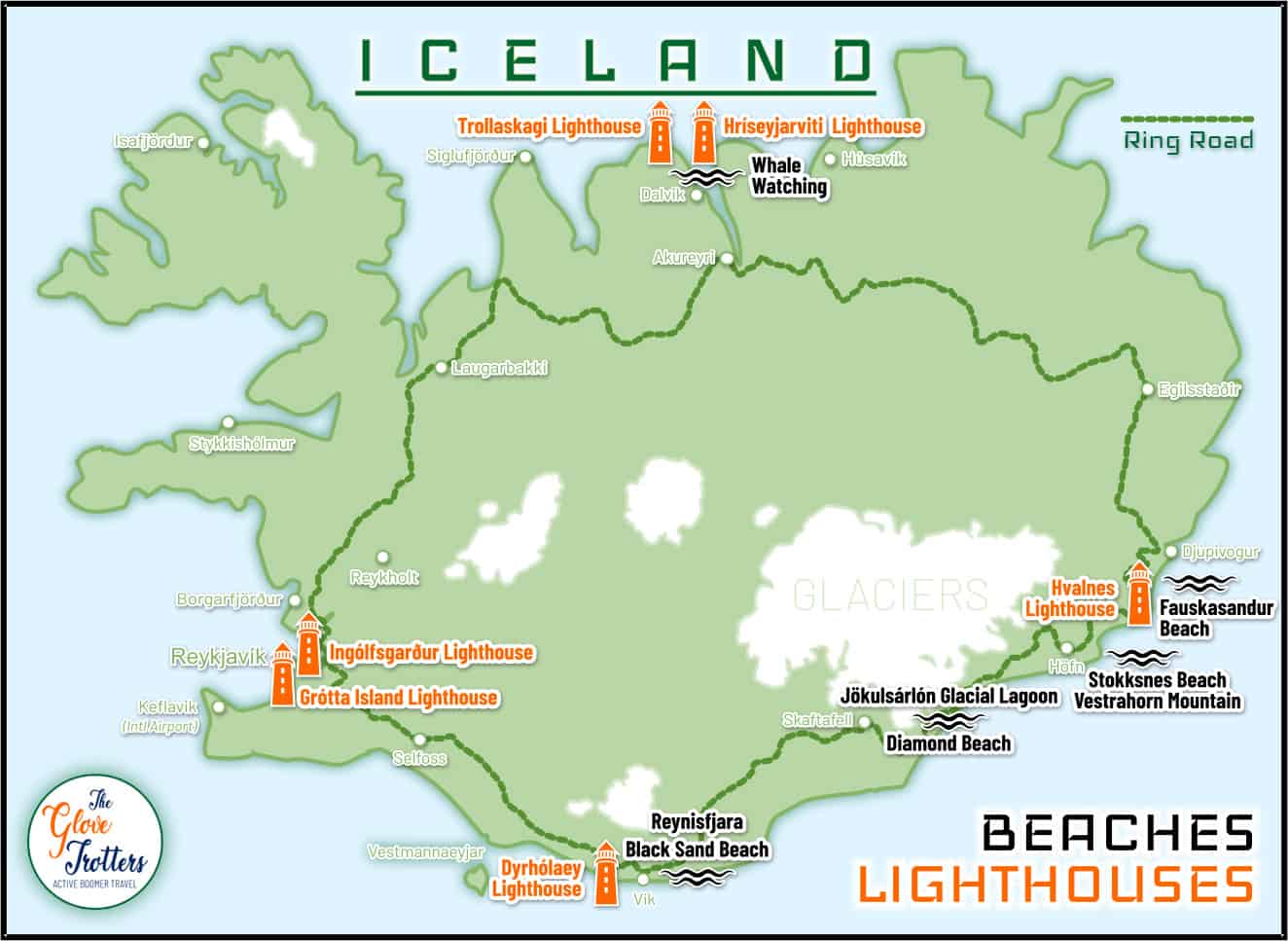
Jump to a specific area.
Reynisfjara Black Sand Beach
Pronounced: rain • is • fee • ah
At the southern tip of Iceland is the remarkable Reynisfjara Black Sand Beach. Like many other Iceland beaches, Reynisfjara’s sand is the result of centuries of lava particles and volcanic fragments carried to the shoreline primarily from melted glacier floods. As you first approach the beach you see the Gardar cliffs to your left (west), supported at its base by vertical basalt columns reaching as high as 60’ (18.3 m). These columns are said to be the primary inspiration for the wings of Hallgrímur’s Church in Reykjavik. It’s also a favorite tourist picture spot and fun climbing wall.
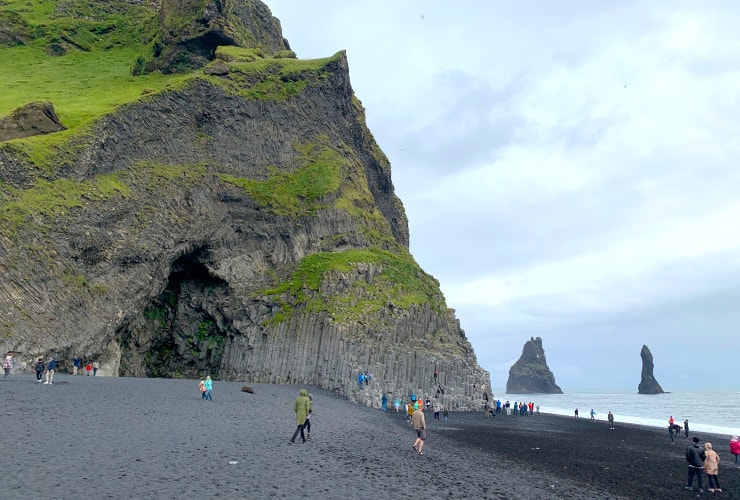
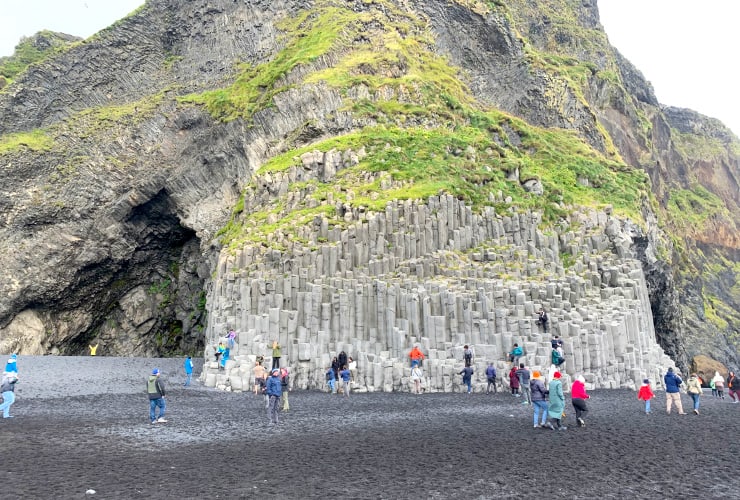
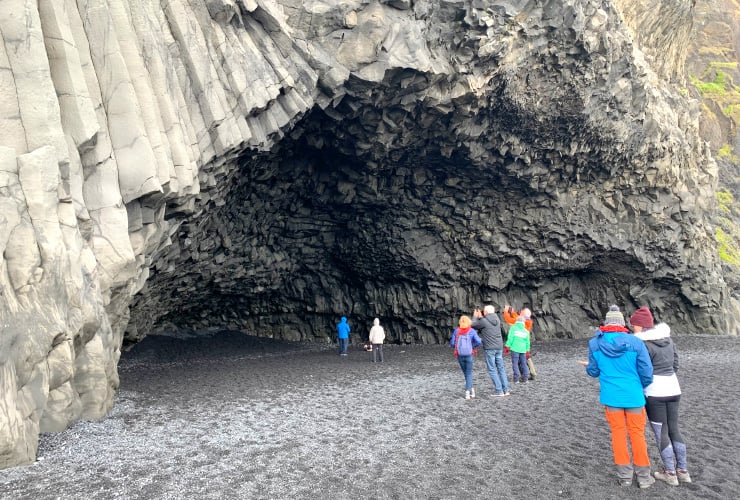
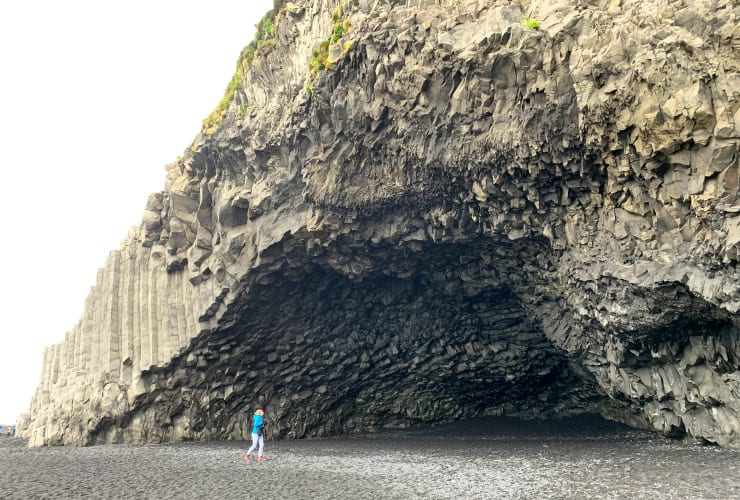
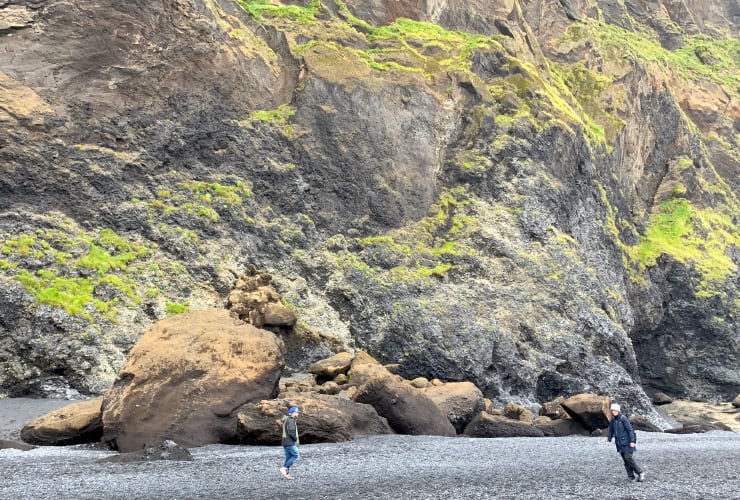
As you continue west there is a carved out section of the mountain that looks like a cave. The walls, and roof, of the carve-out are entirely made up of the vertical basalt columns. It appears quite dark from the sand but lightens up as you descend. It also produces some interesting acoustic effects. Further on the rocks also include much larger boulders as the cliffs show the strata layers formed over the millennia. The cliffs also have different shades of colorful green moss. If you look up, you’ll see a healthy community of Northern Fulmar birds flying and nesting high up on the cliffs.
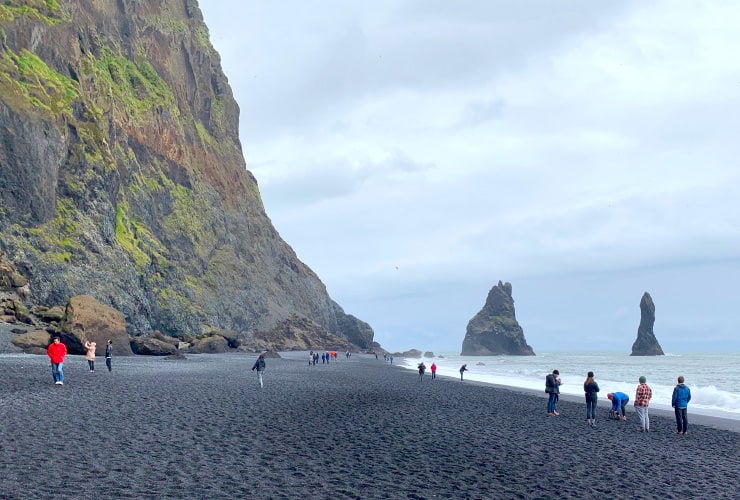
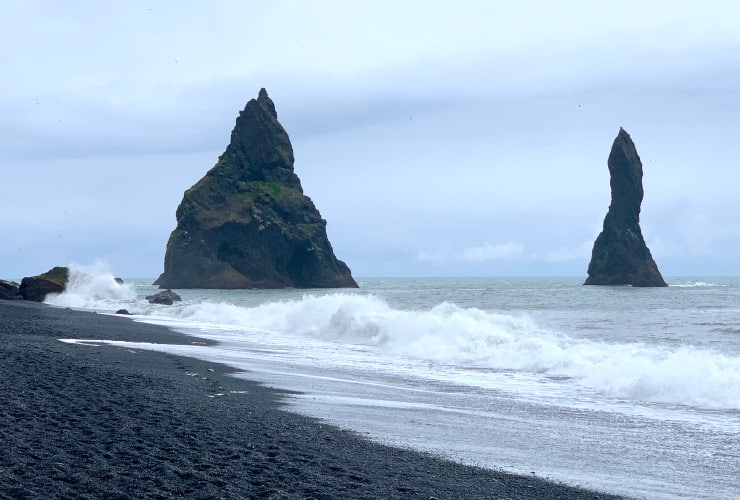
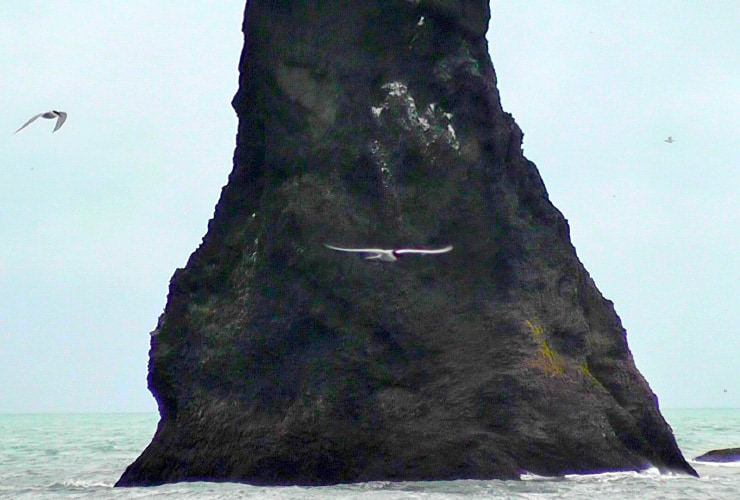
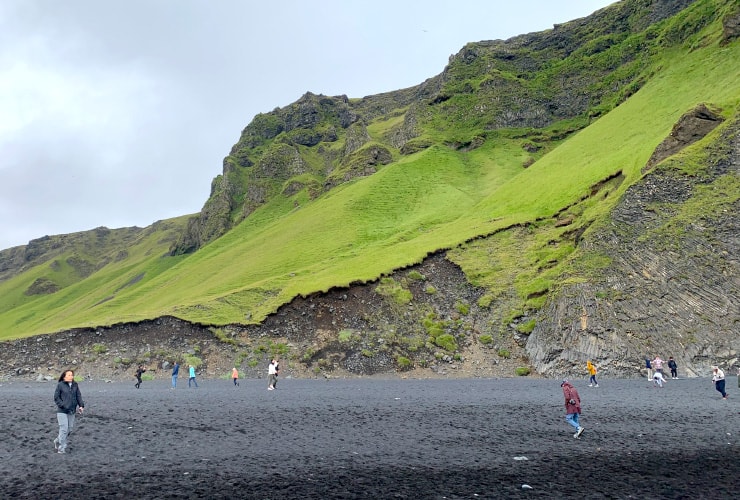
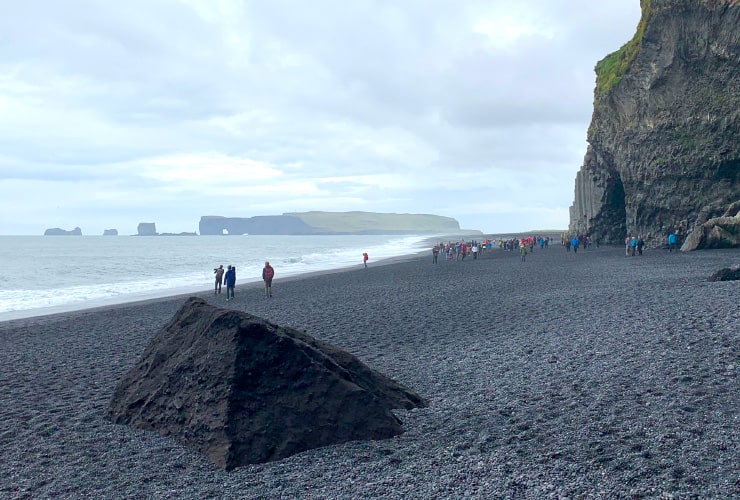
As you approach the cliffs the sand beneath your feet shifts into multi-colored and shaped smooth pebbles that are quite comfortable to the touch. To the south, just off the shoreline, you’ll see two ascendant rock spires. These “sea stacks” are known as Reynisdrangar. Legend has it that these basalt rock spires were once trolls that stayed in the water past dawn and were turned into stone. If you’re a bird watcher the spires are home to a variety of species including guillemots, puffins and fulmars. To the east, in the distance, is Dyrhólaey and its beautiful iconic rock formations as well as the Dyrhólaey Lighthouse just peaking its lamp above the highest point. Reynisfjara is definitely one of the best Iceland beaches and lighthouses the “land of fire and ice” has to offer.
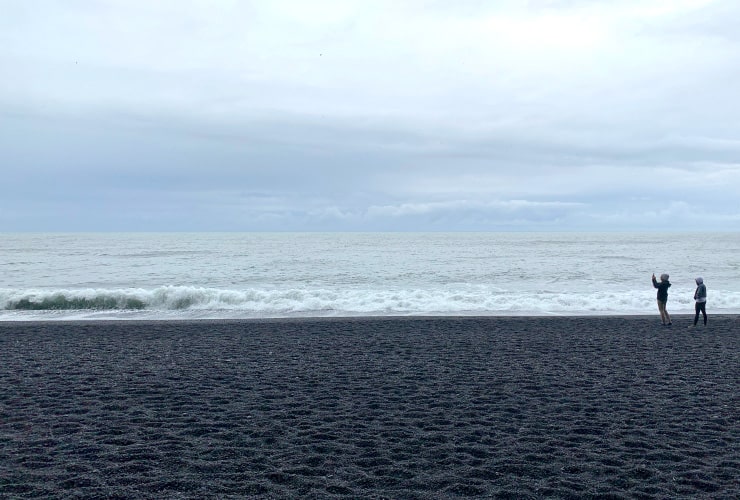
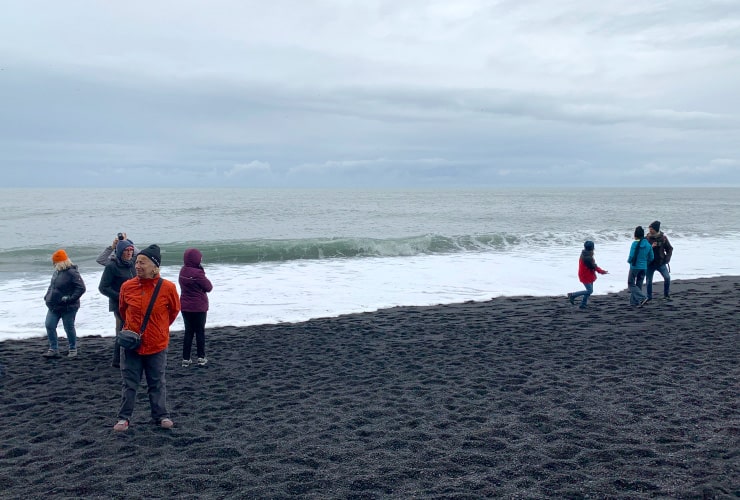
Fjallsàrlón Glacial Lagoon
Pronounced: fee • an • sah • loan
The Fjallsàrlón River Glacier is genuinely one of the most beautiful places on earth . . . and many visitors to Iceland don’t even know it exists. There are no directional signs on the Ring Road or at the lagoon itself. We got lucky to have it included on our 8-day tour with Arctic Adventures. If you do a Google search, they try to steer you to its larger, and more famous, “brother”, Jökulsárlón. Because it is secluded the experience is that much more spectacular. Located on the southern end of the Vatnajökull glacier, Fjallsàrlón is a horseshoe lagoon with Europe’s largest glacier as a backdrop. You can walk right down to the water’s edge and even touch some of the smaller ice chunks.
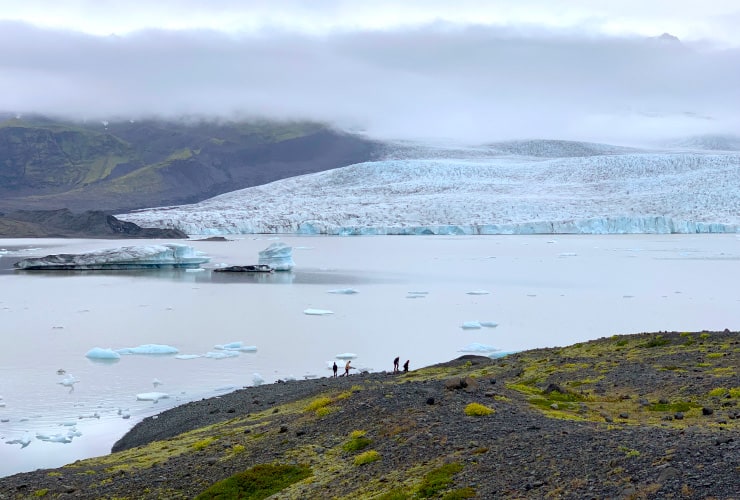
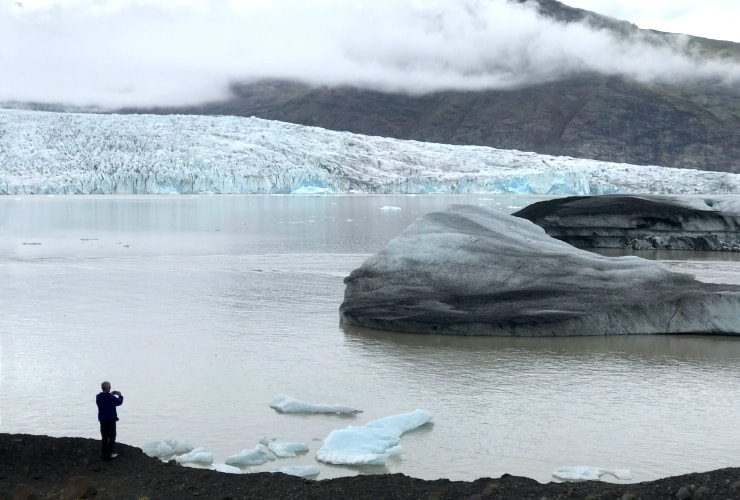
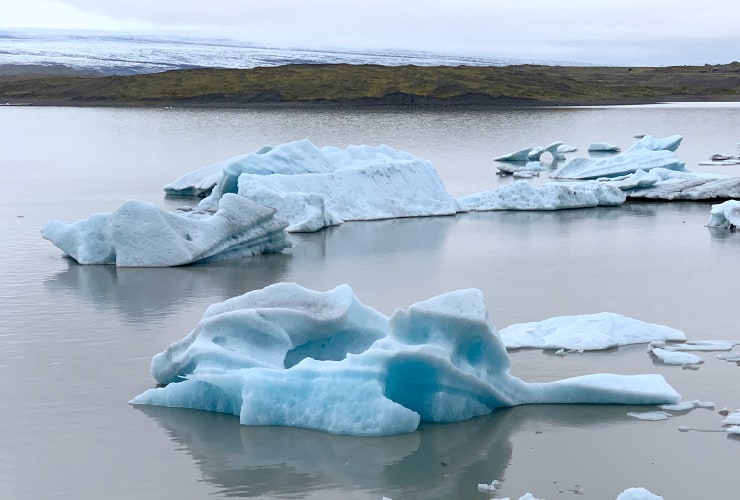
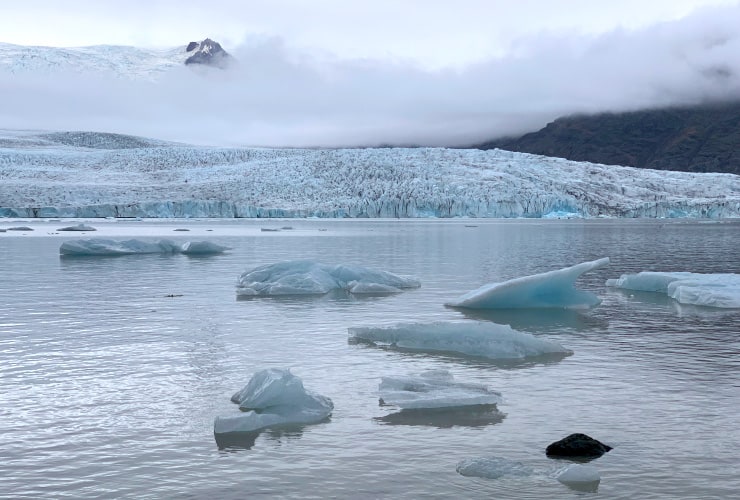
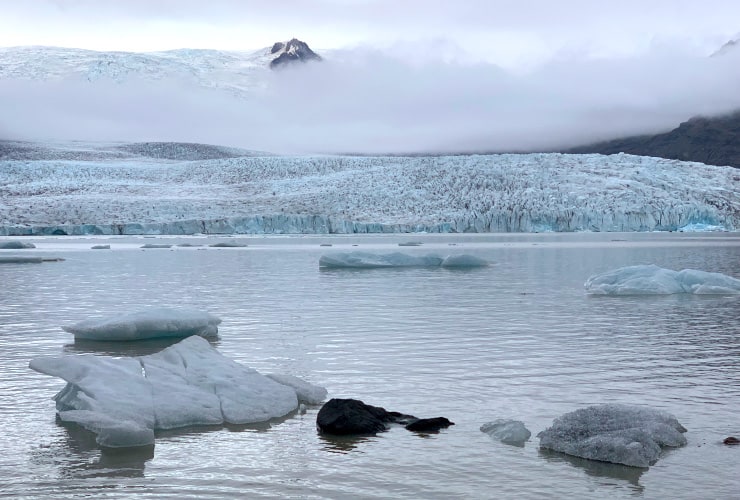
Fjallsàrlón translates to mean mountain river lagoon and that is an accurate description. The experience is quite tranquil, peaceful and visually breathtaking. The Vatnajökull glacier reflects off the calm surface of the water disrupted only by icebergs and icecaps of various shapes, sizes and colors that range from volcanic black, clear and crystal blue. The glacier provides a spectacular frame from its shoreline walls to the top of the volcano mountain looming above. You can charter boat rides through the lagoon year around, except in the winter months, to get even more close-up looks of the glacier and icebergs.
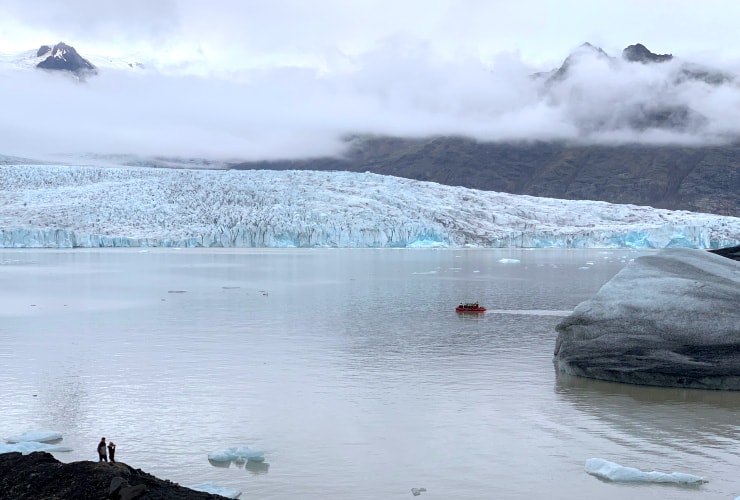
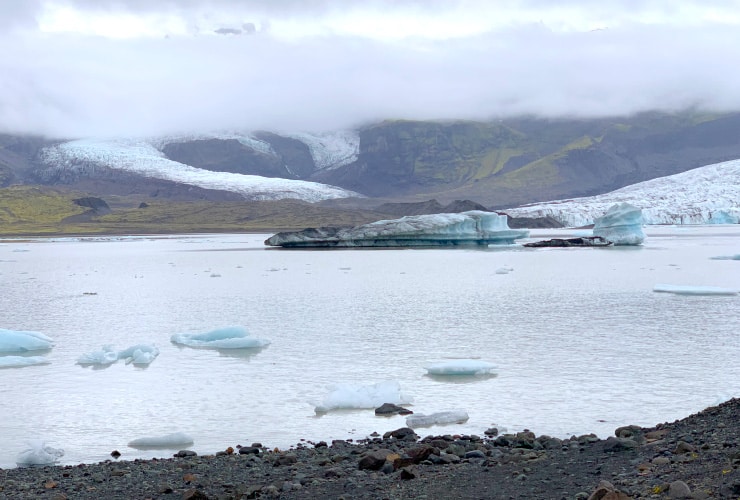
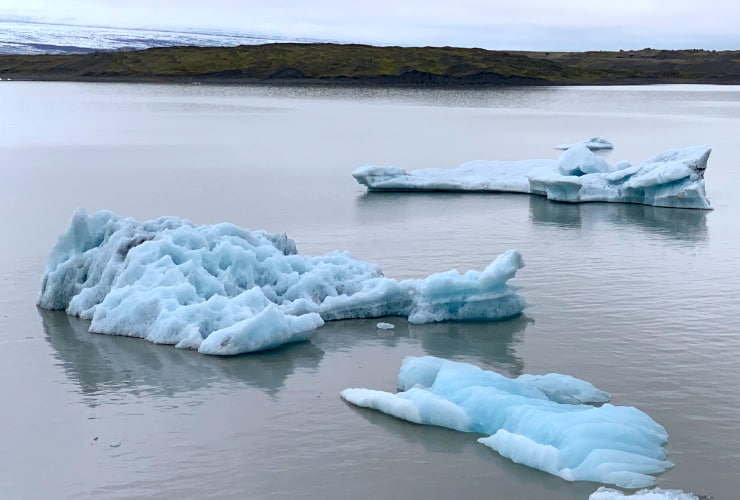
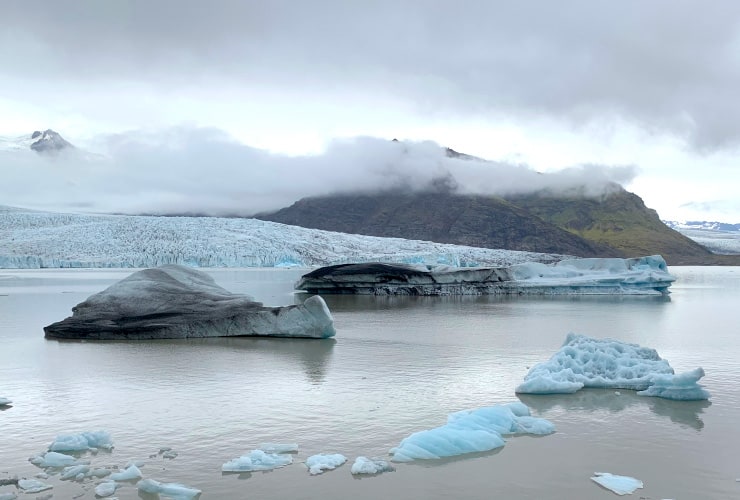
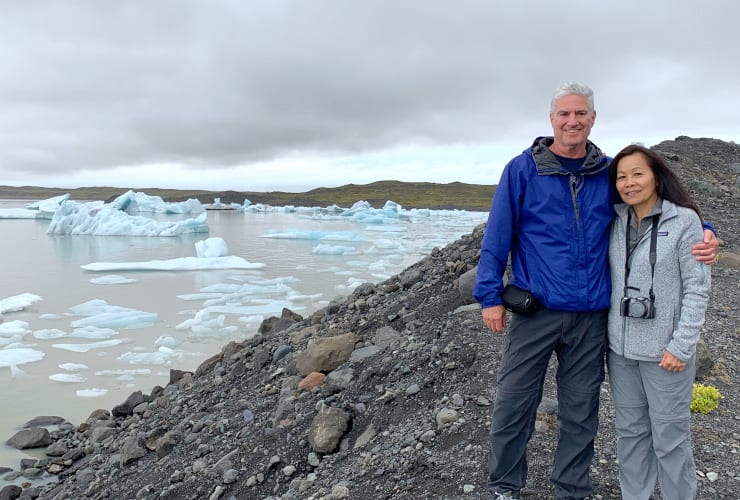
Diamond Beach
Continuing east along the Ring Road you eventually cross the Jökulsá á Breiðamerkursandi or Jökulsárlón River. To your right is one of the best Iceland beaches and lighthouses, the world-famous Diamond Beach. It gets its name from the icebergs that wash onshore from the Jökulsárlón Glacial Lagoon located on the opposite side of the river. As you approach the beach from the parking lot you first encounter the wreckage of a 1,375’ (419 m) boat followed by a 900’ (274 m) walk along the black sand beach to the shoreline. Along the way you are dazzled by not only what you find washed up on the beach but what you see in the water as well.
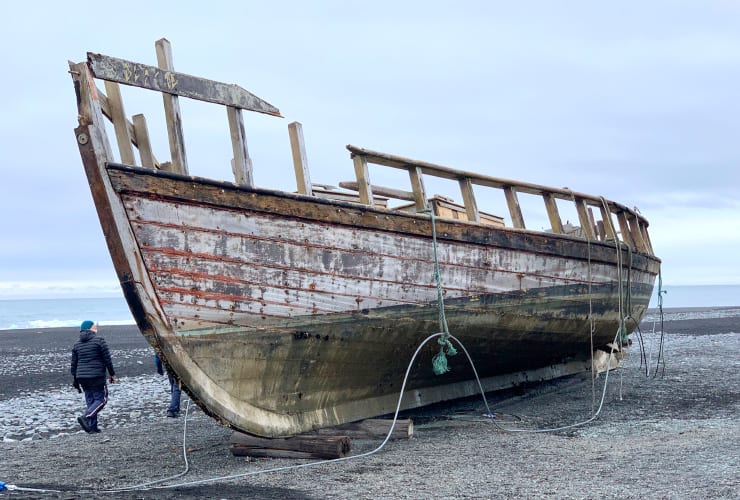
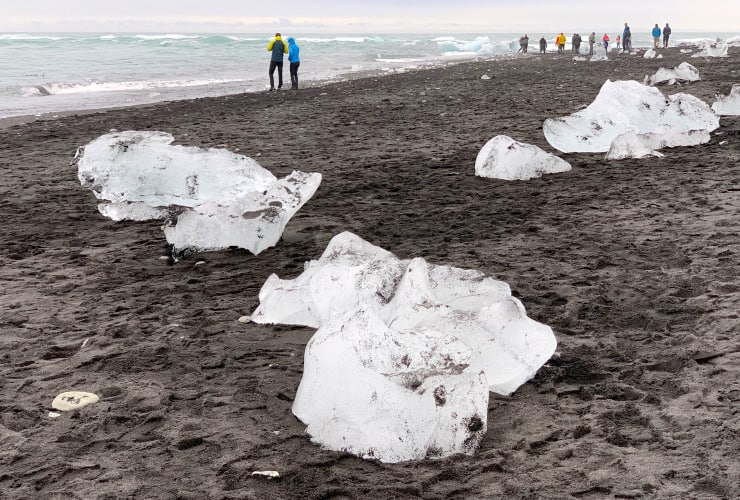
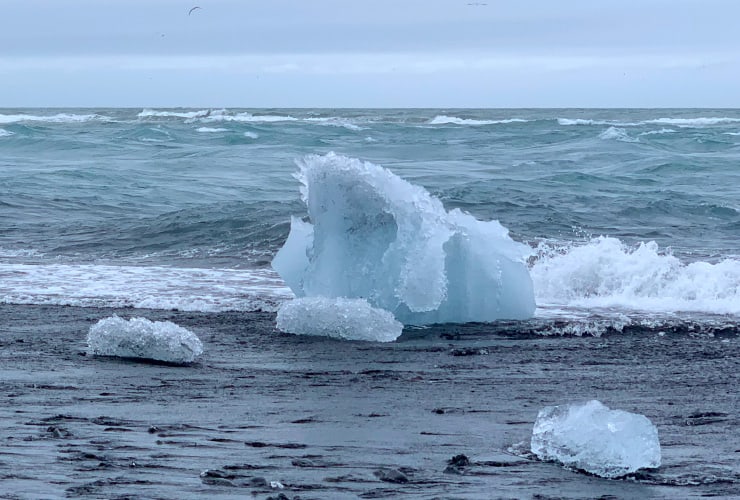
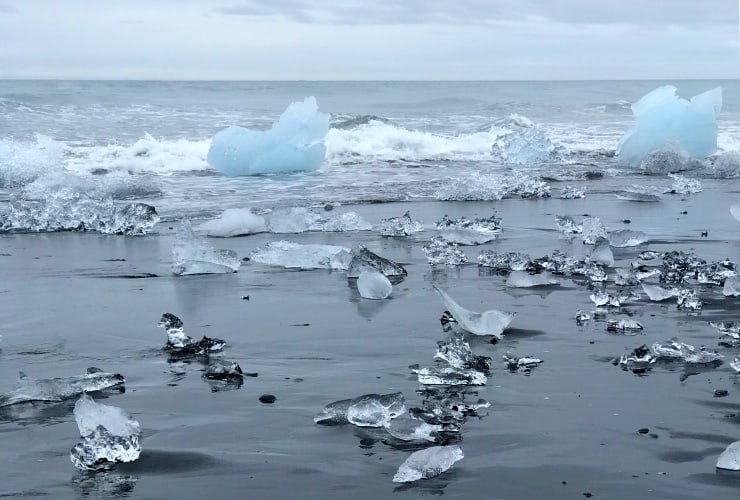
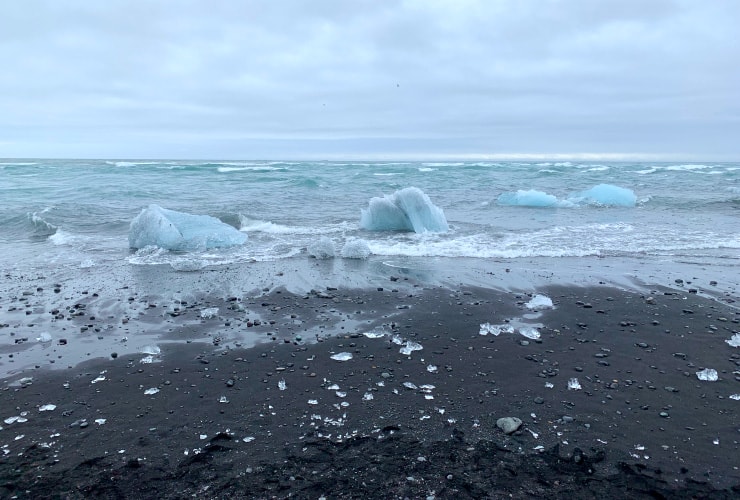
The icebergs that have escaped the Jökulsárlón Glacial Lagoon have either pushed their way onto the beach or cemented themselves, albeit temporarily, in the water itself. The result is a remarkable contrast between the black sand of the beach and the sparkling radiance of the ice chunks that defies the imagination. Each iceberg is utterly unique in shape, size and reflection. Some are large enough to sit on (carefully) while others can fit in the palm of your hand. They vary in color from clear and white to a remarkable aqua blue that produces a stark contrast to the darker water it sits upon.
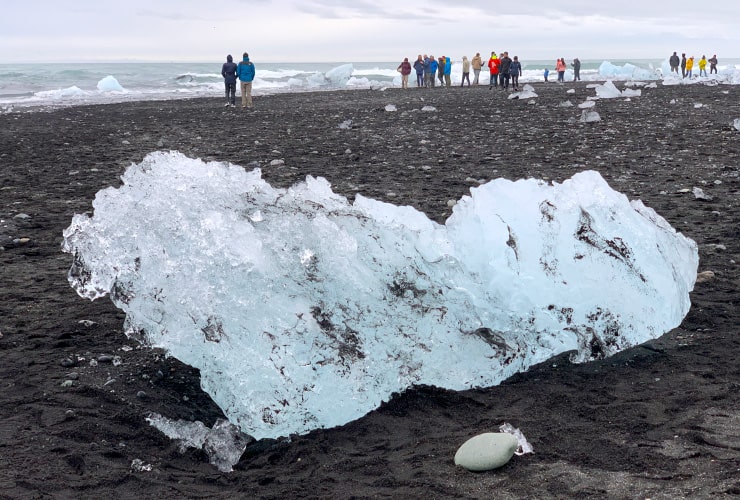
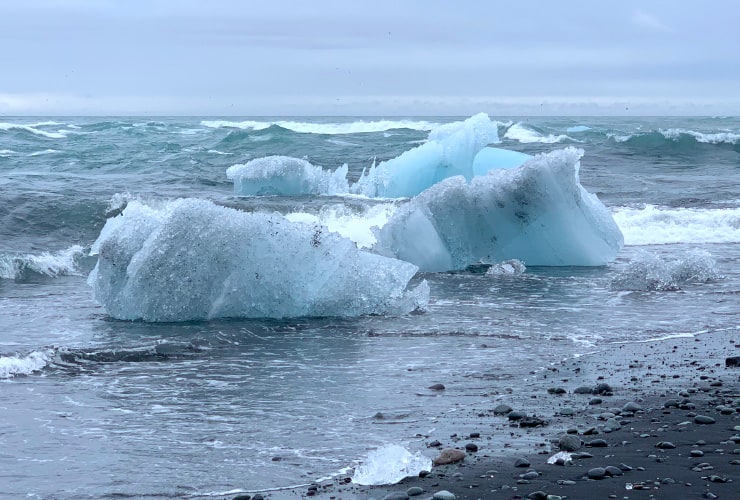
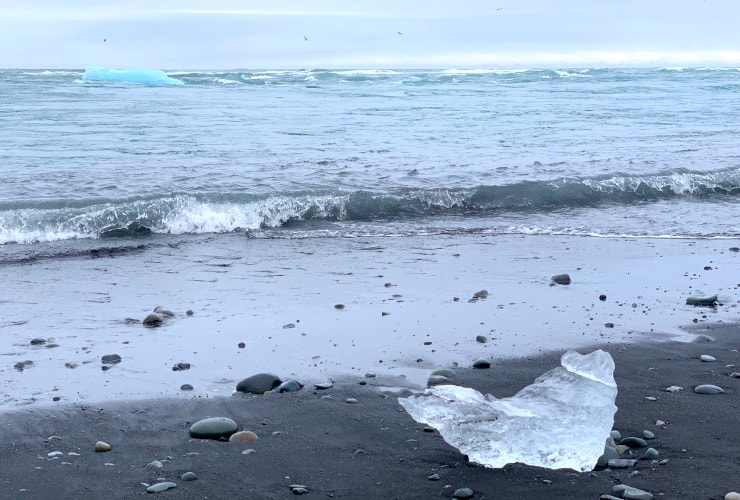
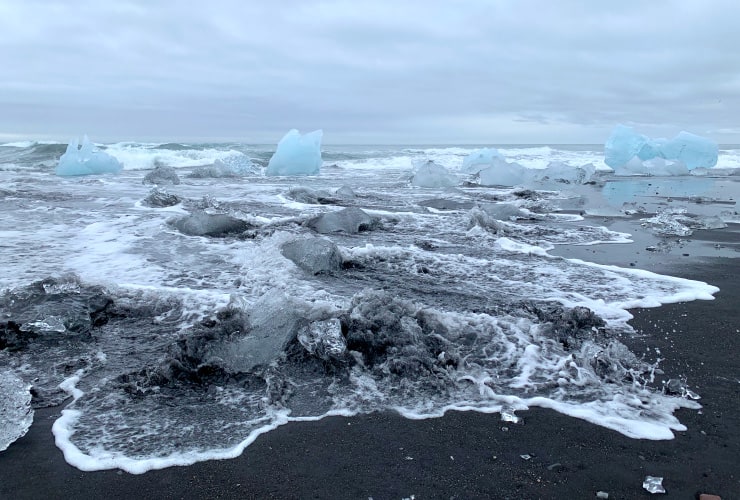
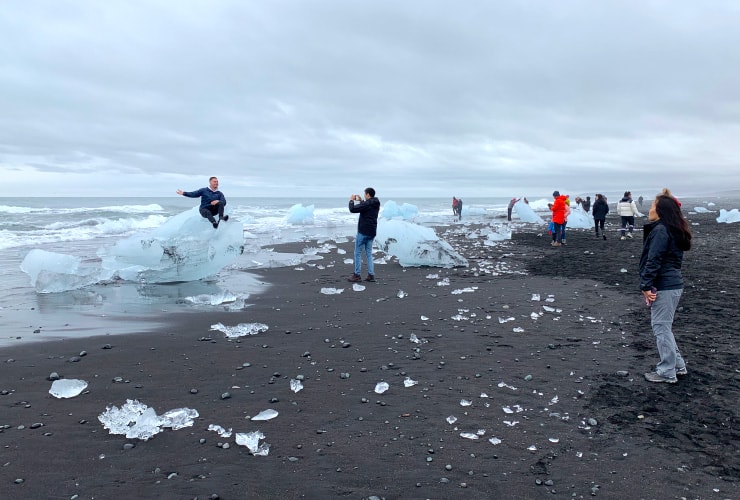
It’s the icebergs in the water that seem the most surreal. The waves are often violent and aggressive pounding against the ice statues. If you look closely you can actually see the icebergs swaying back and forth in the surf. Some of the icebergs are a deep blue and look almost like life rafts while others resemble city skylines. Unfortunately, there are those visitors that don’t have an appropriate appreciation for their surroundings. Some were crushing the smaller ice shards with their feet and others sitting atop some of the larger icebergs and breaking them. As with Reynisfjara be aware of the dangers of the surf. While there are no rip tides or sneaker waves the surf is still strong, ice cold and potentially hazardous.
Jökulsárlón Glacial Lagoon
Pronounced: tune • pee • ro • ush
On the opposite side of the Ring Road from the Diamond Beach is the legendary Jökulsárlón Glacial Lagoon. Featured in numerous Hollywood productions Jökulsárlón tops many lists of the best Iceland beaches and lighthouses. Similar to Fjallsàrlón, and significantly more crowded, this lagoon features larger icebergs resting on a larger body of water. Some of the icebergs are thought to be over 1,000 years old but this particular lagoon has experienced significant growth in just the past half century.
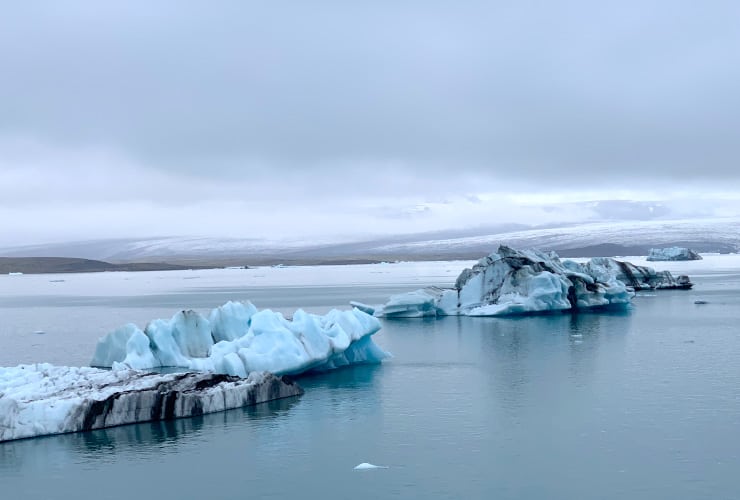
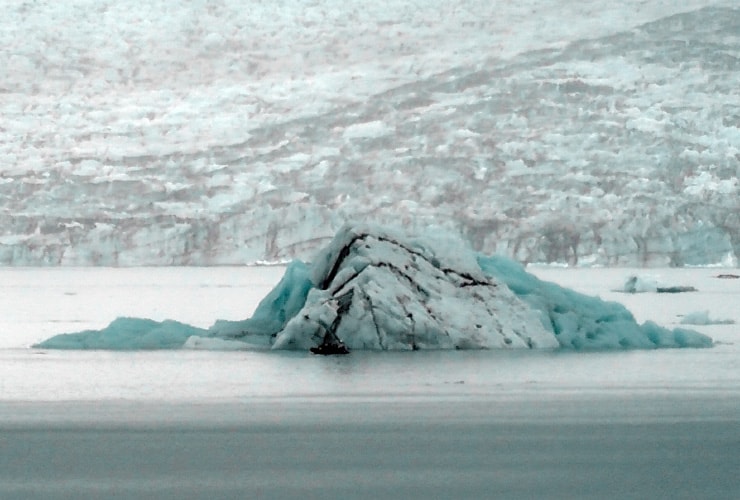
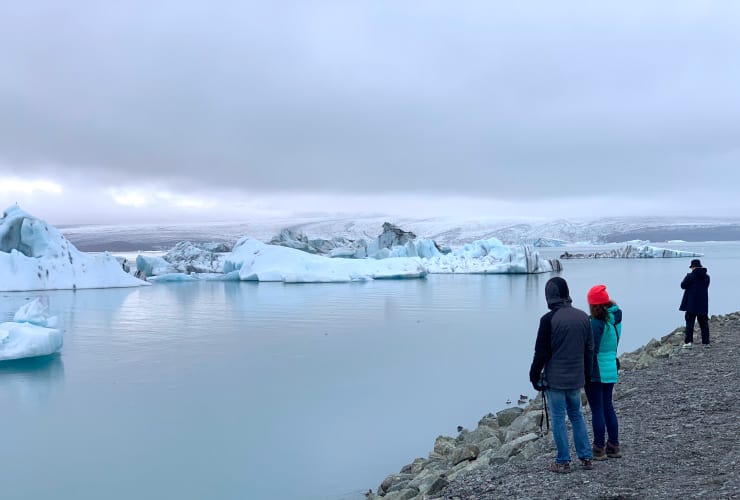
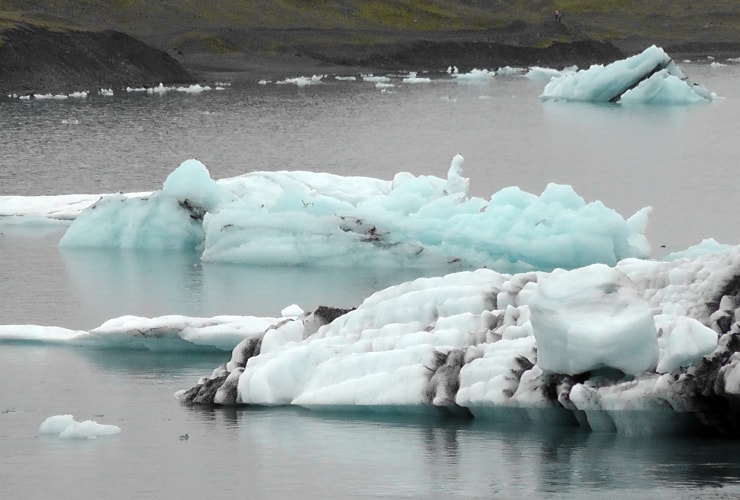
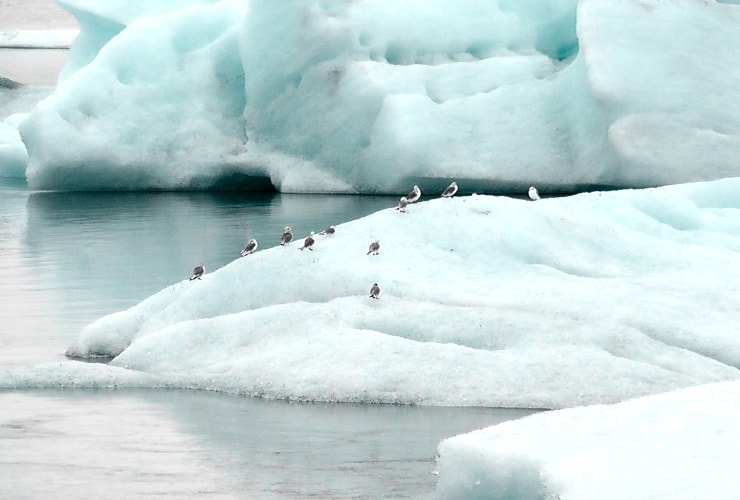
One of the coolest things about the Jökulsárlón Glacial Lagoon is it’s ever-changing nature. Each time you visit it will look different. As the Breiðamerkurjökull glacier continues to melt, ice shards fall off into the water where they slowly break down taking on different shapes as they erode. The lake is actually a mix of fresh and sea water which accounts for its unique color. This lagoon is also home to numerous birdlife including the Arctic Tern and Tufted Duck. As you approach the shoreline there is a hill, complete with a spiraling stone path to the top, that provides a nice overview perspective.
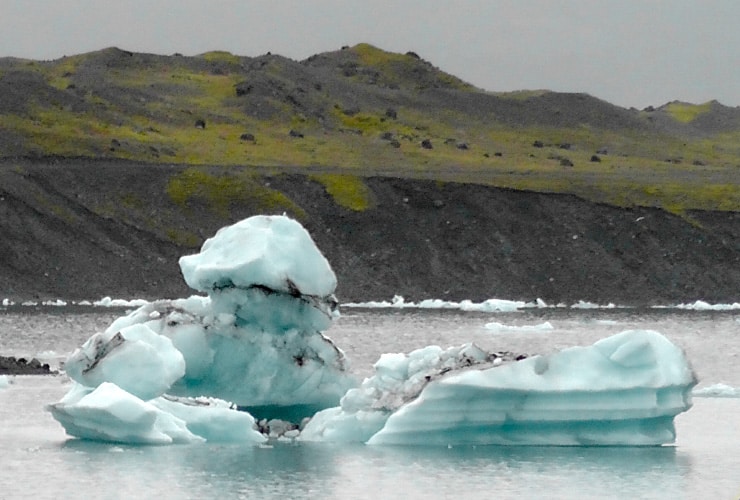
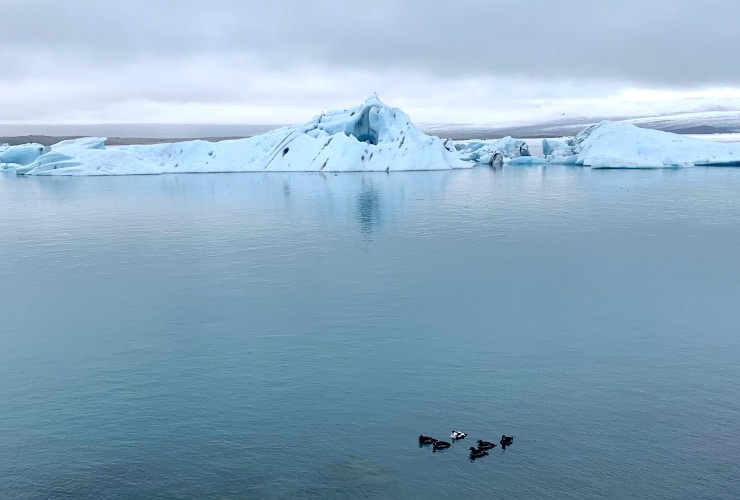
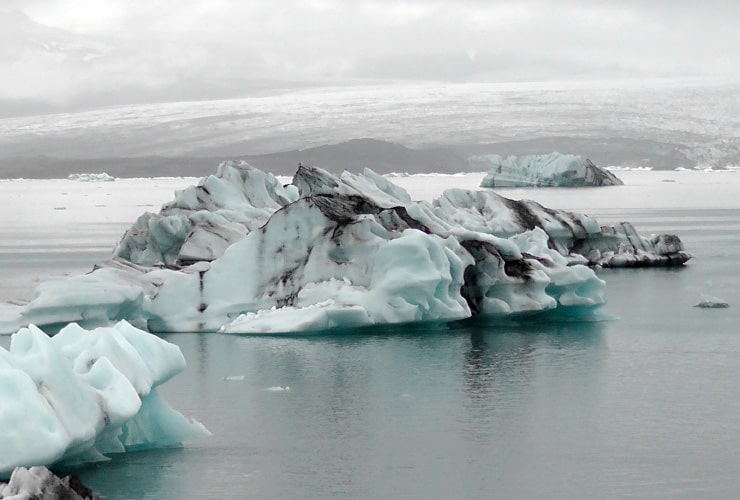
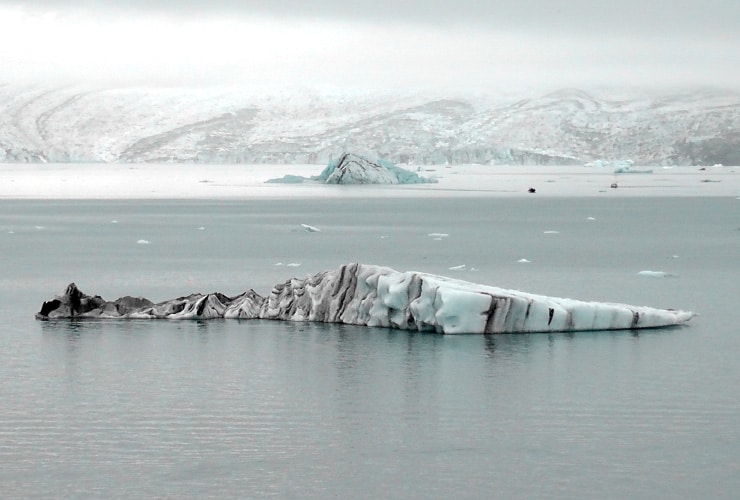
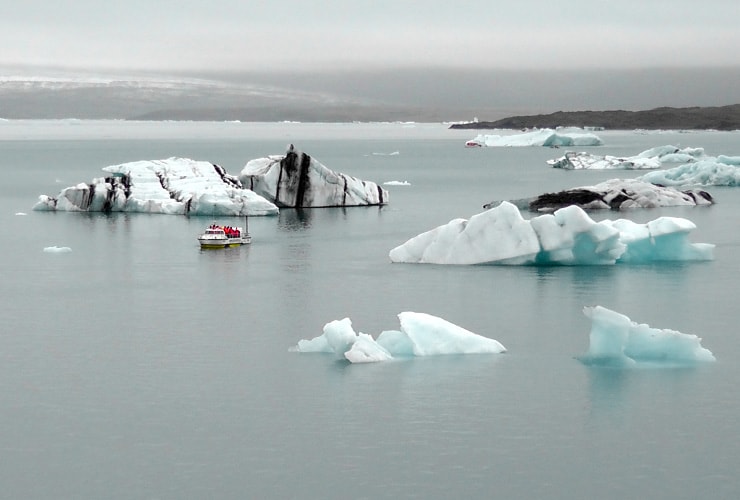
The reason visitors flock to Jökulsárlón are the icebergs. They are in such a divergent array of colors, shapes and sizes. While some are flat others are stacked on top of one another. Some are white while others take on various shades of blue and green. Some are smooth and round, some have grooved patterns (both vertical and horizontal) while others have adopted a shape resembling mountainous terrain. Many have black volcanic stains that reflect off the still water. As with Fjallsàrlón, you can charter boat tours to take you around the lake. Observing the small size of the passing watercraft helps you to appreciate the enormous girth of many of the icebergs.
Stokksnes Beach
Pronounced: stock • ch • ness
The Stokksnes peninsula is another of Iceland’s black sand beaches. The volcanic residue sand and grassy clumps make Stokksnes a favorite spot of photographers and an easy addition to the best Iceland beaches and lighthouses. This peninsula has some history attached to it as well. It’s the site of one of the earlier settlements on the island (9th century) as well as a strategic military location for the British army during WWII. To access the beach, as well as the Viking Village at the base of Vestrahorn, there is a small access fee that will get you through a gate that leads to a narrow path which runs along the eastern side of the peninsula.
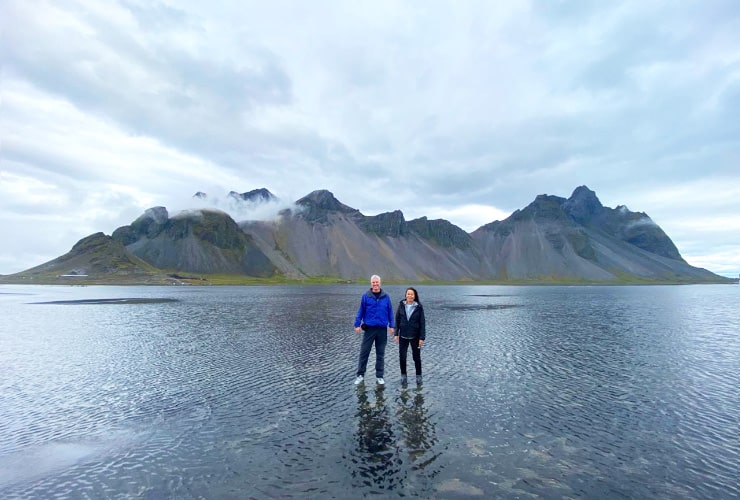
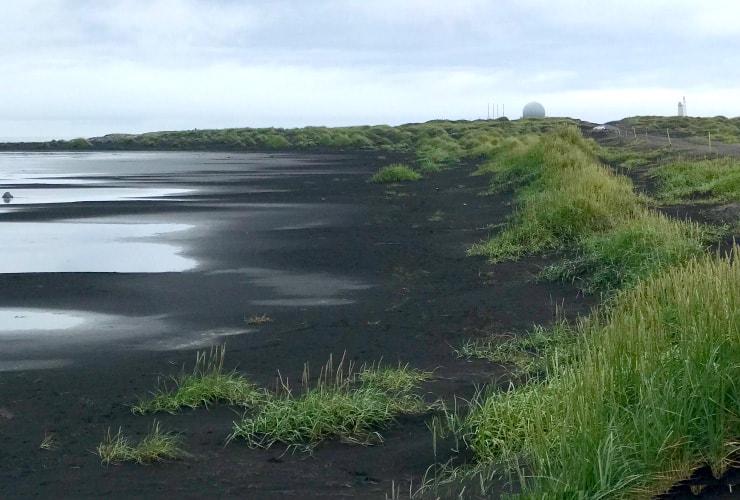
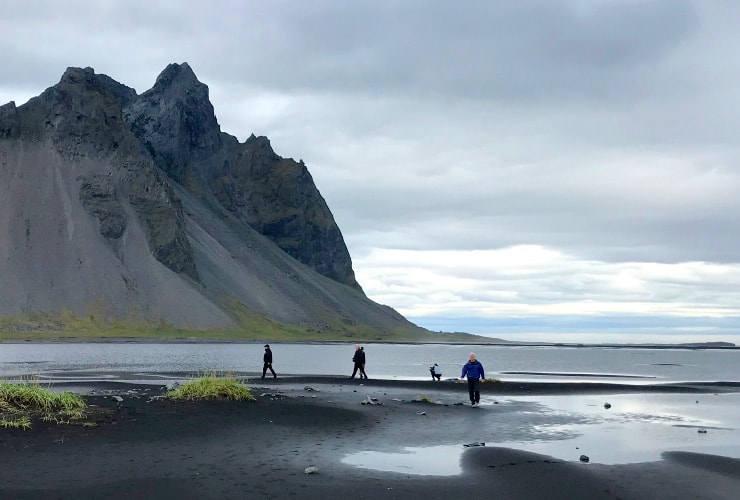
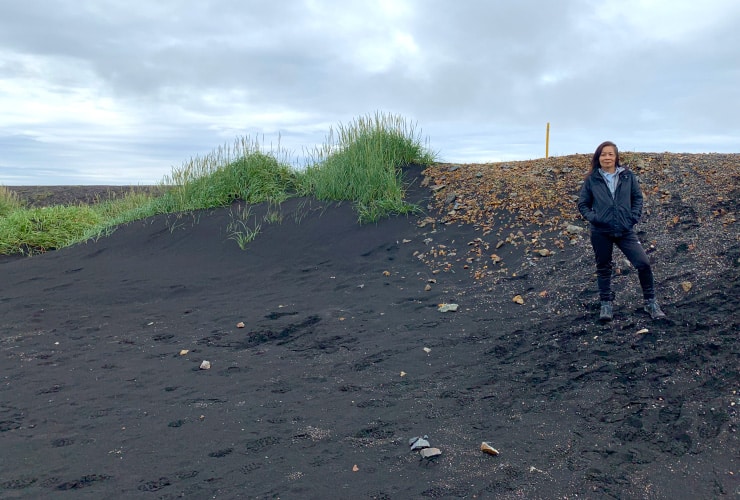
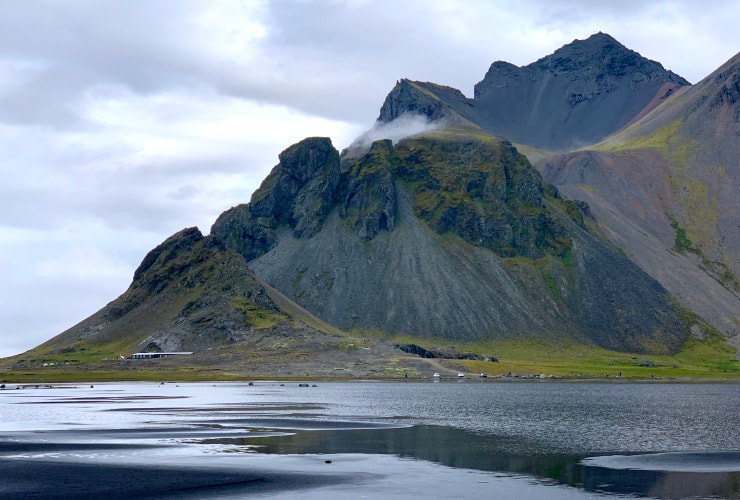
As beautiful as the beach area is, Stokksnes is best known for the remarkable backdrop of Vestrahorn Mountain. While so many of Iceland’s mountains are flat-topped, due to the heavy weight of glaciers over the millennia, Vestrahorn has distinctively craggy peaks. Vestrahorn, also known as Batman Mountain, has peaks that reach as high as 1,490’ (454 m) and measures approximately 10,390’ (3,167 m) in width. It’s estimated Vestrahorn dates back 8-11 million years. When the tide is ideal you can walk out onto the water and take dramatic shots that make you appear to be standing on water. The view and tranquil surroundings make Stokksnes beach one of the best Iceland beaches and lighthouses.
Fauskasandur Beach
Pronounced: foosh • grass • sam • fish
Fauskasandur Beach can be seen as you drive along the east shore of the Ring Road. There is a convenient gravel parking area that is seldom crowded. You can simply stand at the top of the cliff and enjoy the beautiful scenery that includes a shear cliff face to your left and a massive monolith rock to your right. If you’re more adventurous you can descend down to the beach level via a semi-steep gravel decline that’s pretty easy to navigate. While technically Fauskasandur is considered a black sand beach it’s really more gray in color.
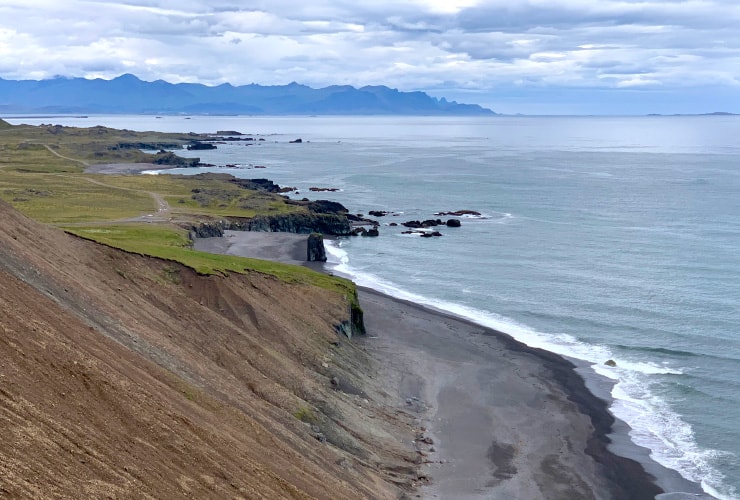
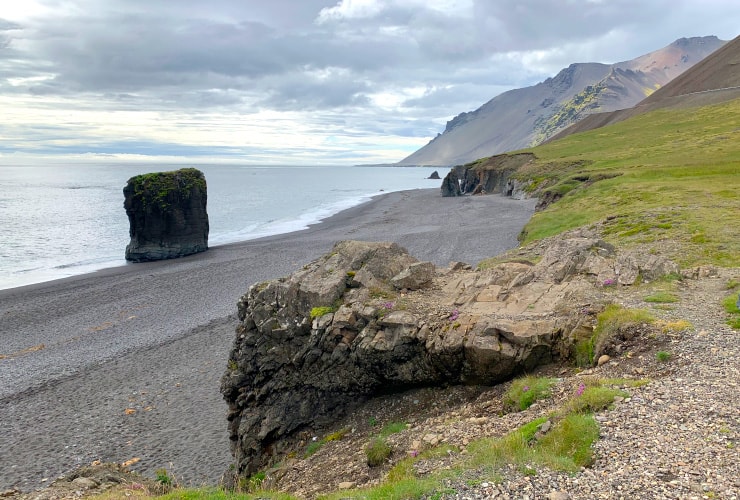
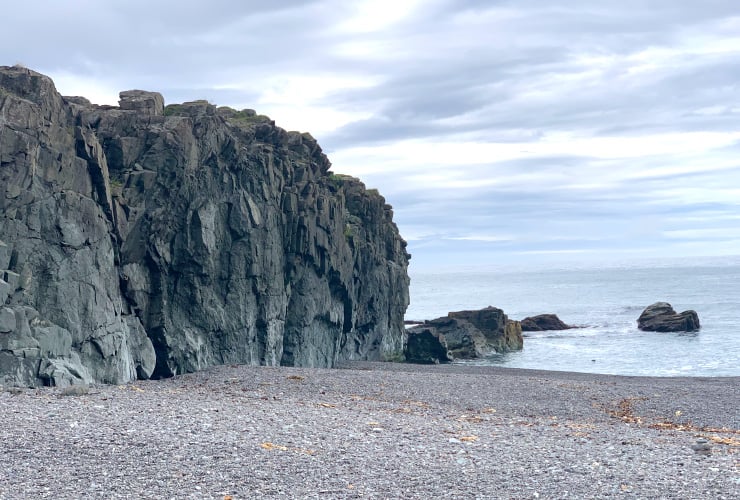
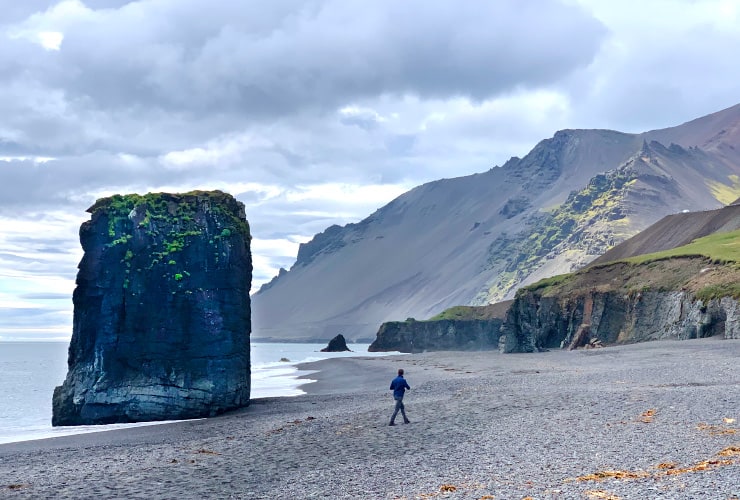
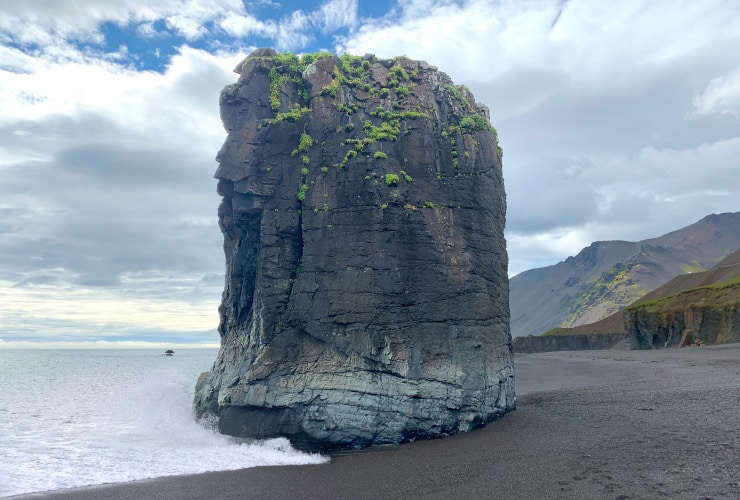
The cliffs to your left ooze with character as do the cliffs just below the parking lot. They look as if a giant took a chisel to their surface with reckless abandon. The main reason this is one of the best Iceland beaches and lighthouses is definitely the rectangular rock monolith that sits stoically right at the shore’s edge. It rises up just under 24’ (7.3 m) and extends out into the surf about 17’ (5.1 m). At high tide it is submerged about 5’ (1.5 m) but at low tide you can walk right up to its base without getting wet. Small grass patches along the top and sides provide a bit of color to this impressive natural statue.
Dalvik Whale Watching
Pronounced: fowl • wheetch
There are few thrills that can match observing nature in their habitat. We had the chance to explore the Eyjafjörður region in northern Iceland by boat and were rewarded with sightings of whales, seals, dolphins, porpoises and puffins. We went with Arctic Sea Tours and, for an additional $85 fee for both of us, chose the speedboat option which allowed us to cover more ground in search of sightings and the sheer thrill of speed. The two crew members did a great job of explaining the various wildlife but also their migratory patterns and why Summer was an ideal time to share the water with these amazing creatures.
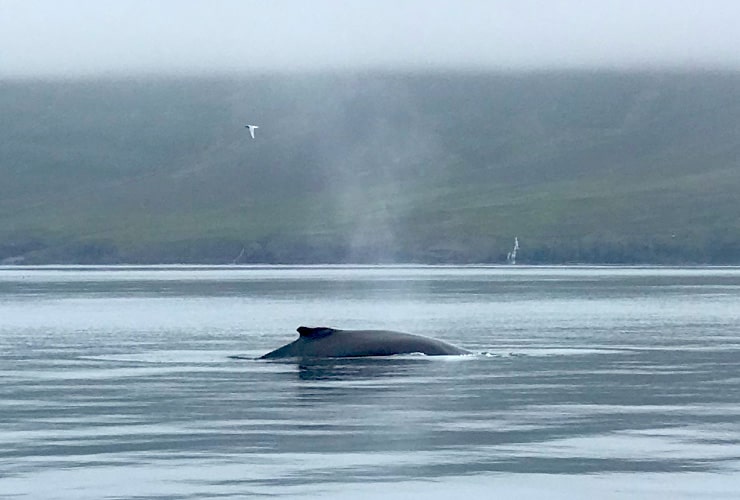
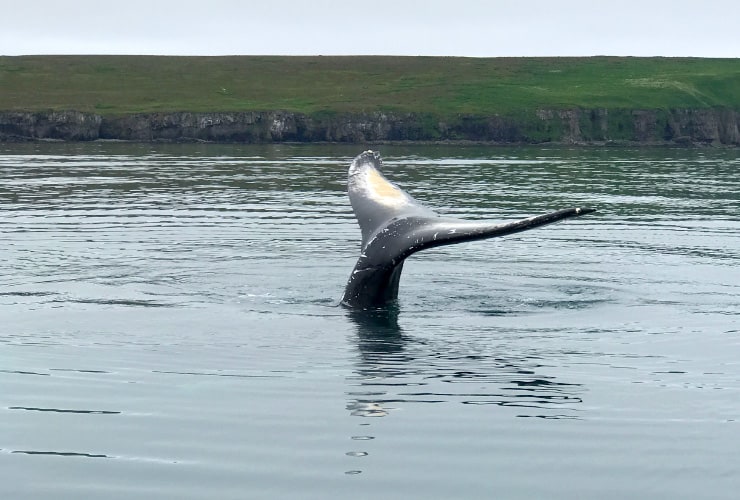
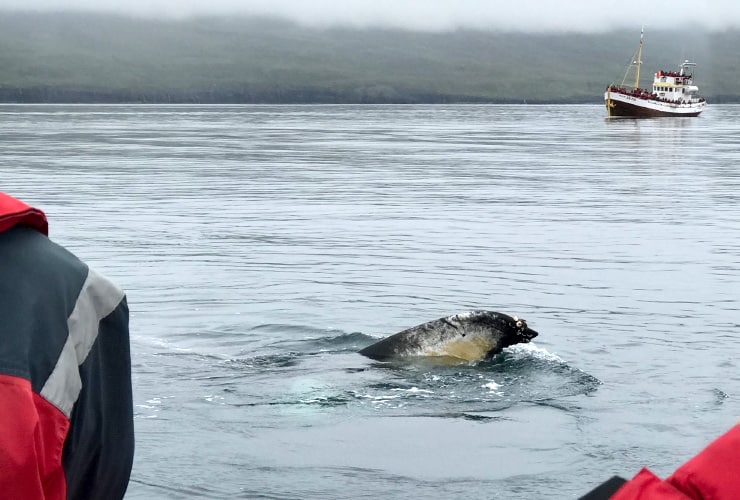
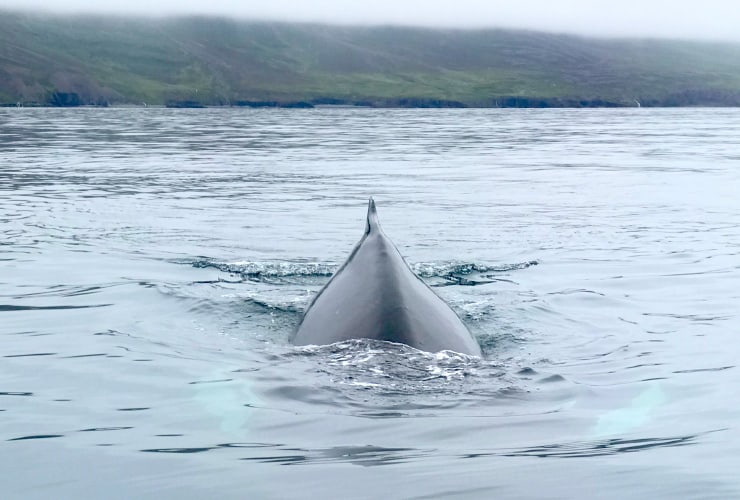
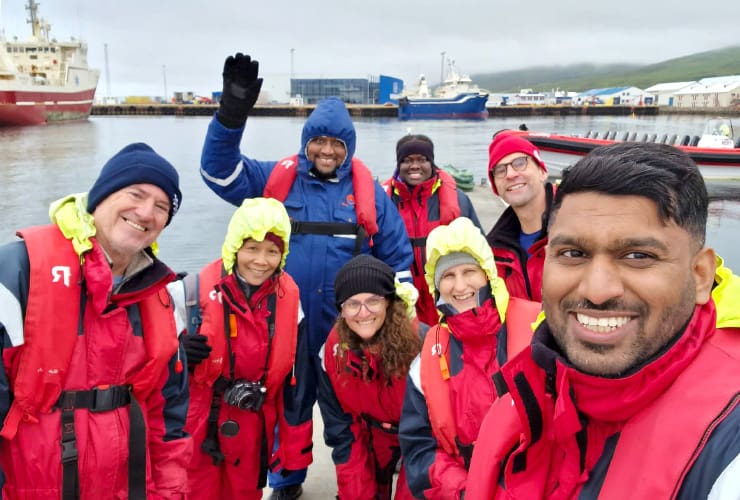
We were fitted with colorful, and warm, safety overalls, given some basic instructions and away we went. It took a little while to spot our first whale but we did site several porpoises (notoriously shy in this region) and Northern Fulmar birds fishing right alongside our boat. One humpback whale went right under our boat but mostly kept their distance. At one point, with several boats watching the same two whales, we took off about a mile north and saw more activity. The dolphins were more hospitable and start showing off for us. Two other highlights to our journey was the bright orange Hrólfskersviti Lighthouse and the amazing Mígandifoss.
Grótta Island Lighthouse
Pronounced: grow • tah
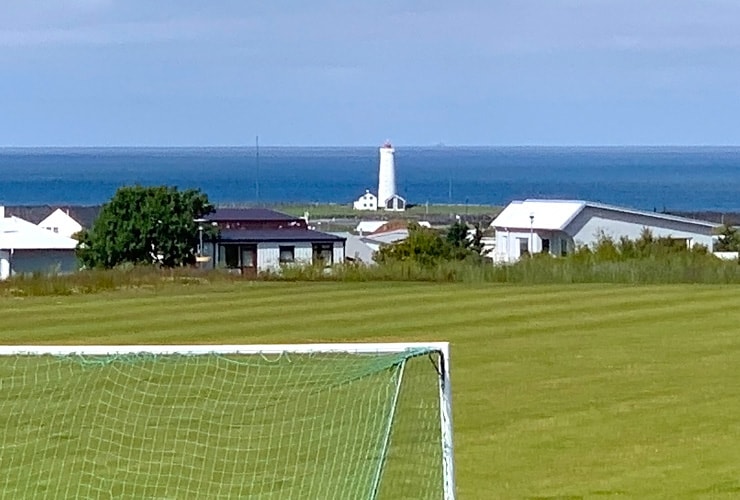
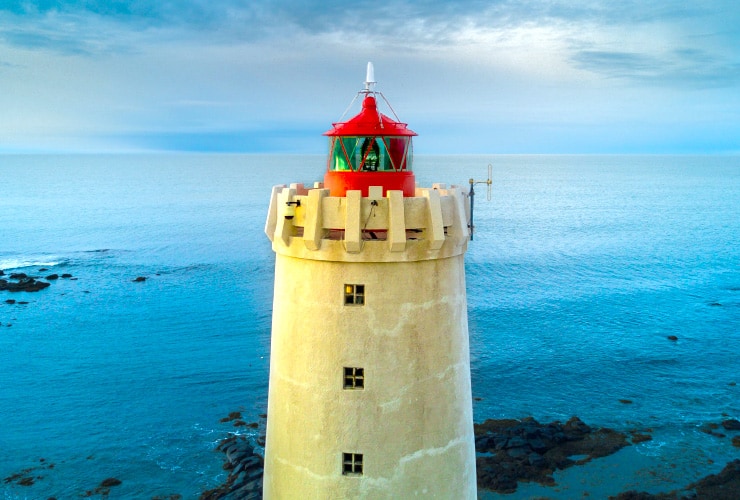
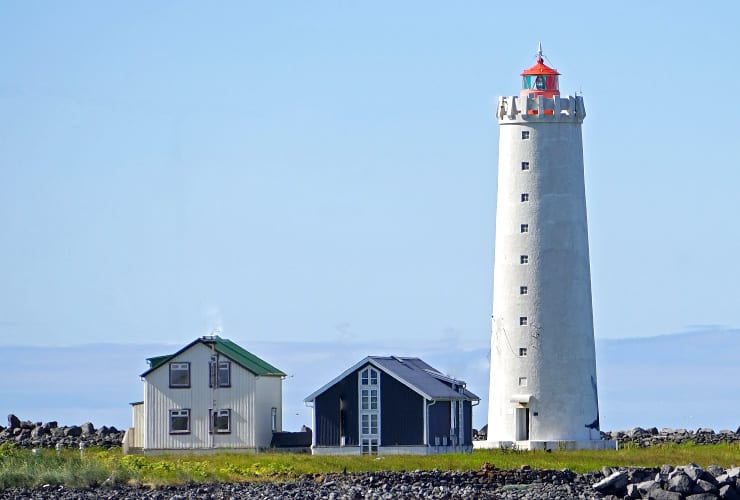
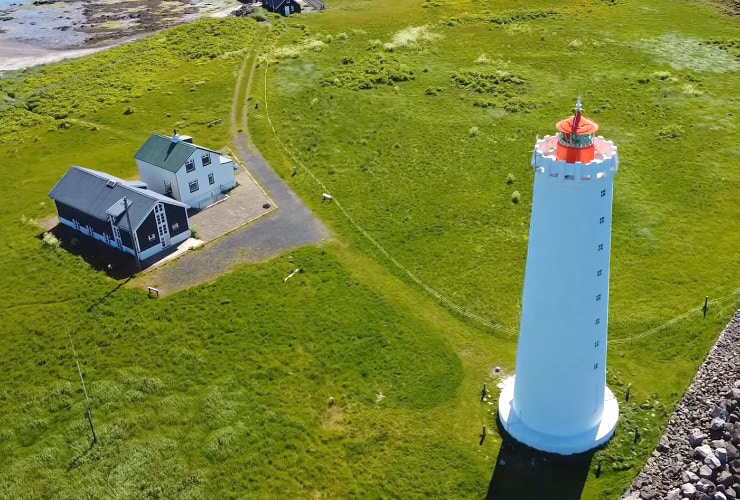
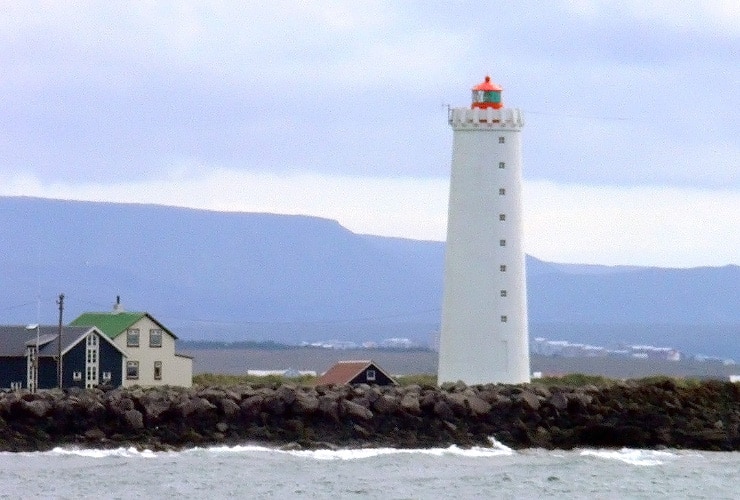
Reykjavik has a few lighthouses sprinkled along its shoreline. The most distinctive one is the Grótta Island Lighthouse. Teaming with an abundance of birdlife, the Grótta area is a protected nature reserve since 1974. The lighthouse has a history dating back to 1897 though the current version was constructed some 50 years later. It is also one of the more popular spots for observing the Northern Lights in winter months. The lighthouse is not always easy to get to as high tides cover the path that connects the parking area from the structure. There are also restrictions (May-mid-July) on access during the breeding season for the more than 100 species of birds in Seltjarnarnes. It is a beautiful lighthouse that, like North Carolina’s Ocracoke Lighthouse, is slightly wider at its base than at its distinctive orange tower.
Ingólfsgarður Lighthouse
Pronounced: een • ghoul • sky • yeesh
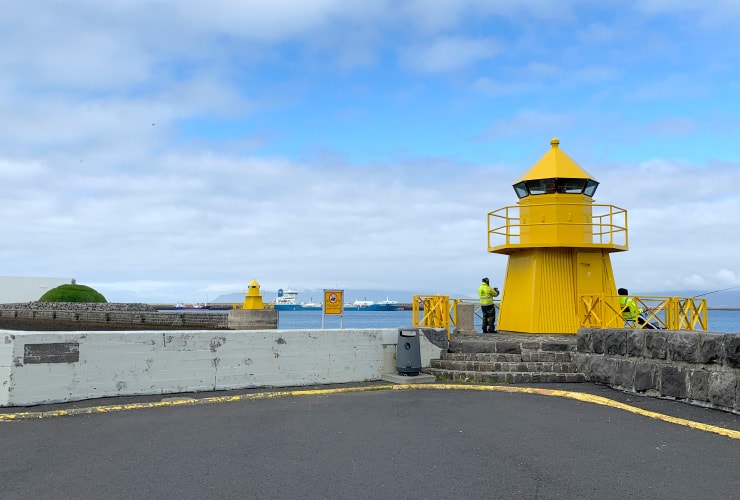
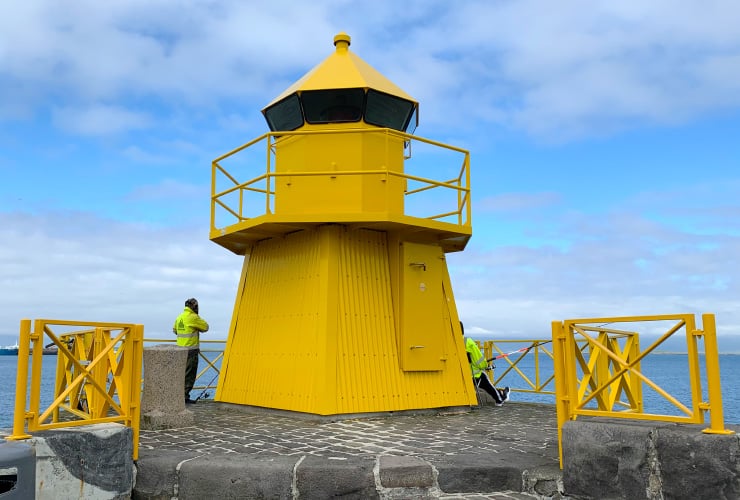
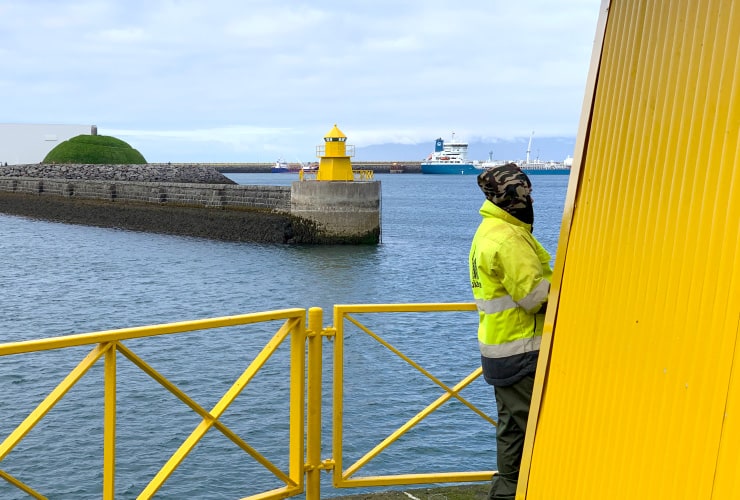
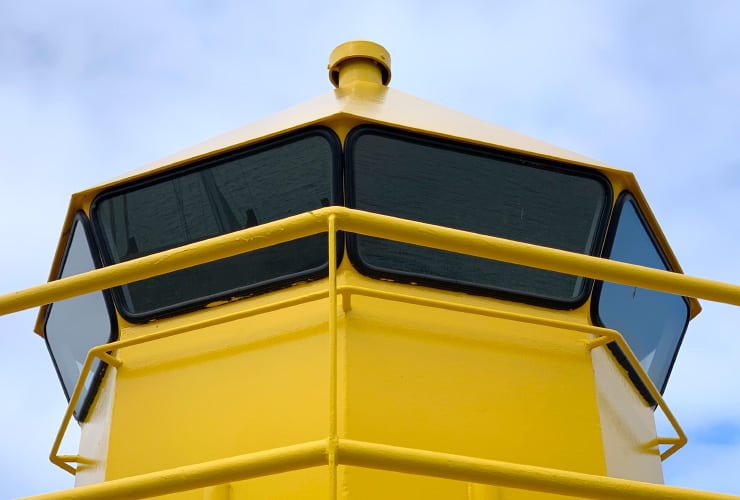
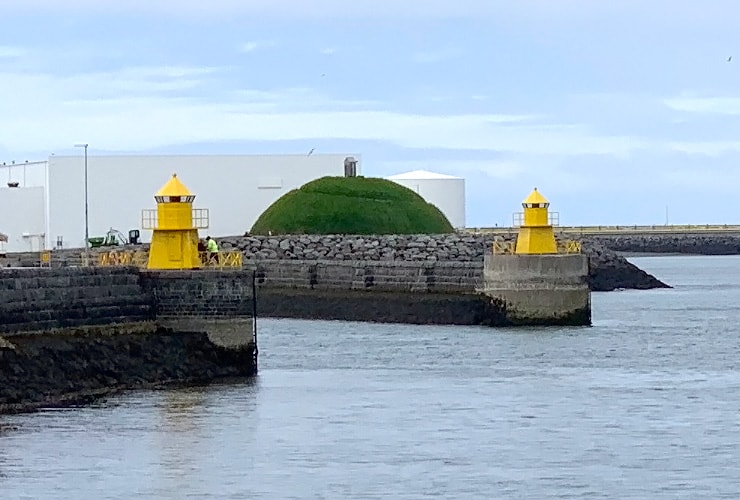
Southwest of the Grótta Island Lighthouse, behind the Harpa Concert Hall, is Reykjavik’s illuminating Ingólfsgarður Lighthouse. Named after Icelandic first citizen Ingólfur Arnarson, it sits staring across the Old Harbor and Faxa Bay at its twin and Þúfa just beyond. It is one of three bright yellow lighthouses you can see along the Sculpture & Shore Walk. One twin is across the bay and the other right behind the Einar Benediktsson sculpture next to the Höfði House. Ingólfsgarður stands just 13’ (4 m) tall with a focal lens of 23’ (7 m) befitting its strictly harbor use. Though small in stature, Ingólfsgarður is one of the best Iceland beaches and lighthouses.
Dyrhólaey Lighthouse
Pronounced: veesh • hole • eye
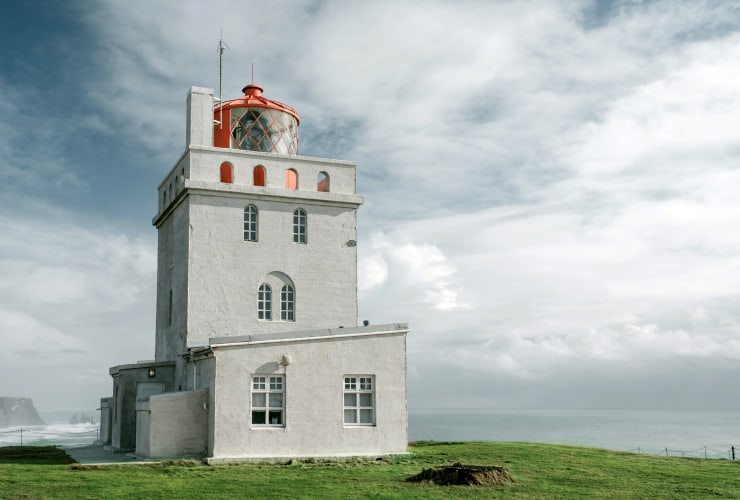
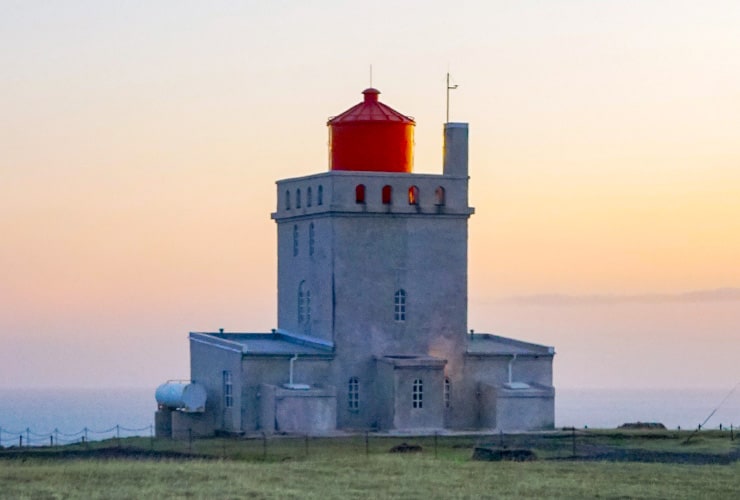
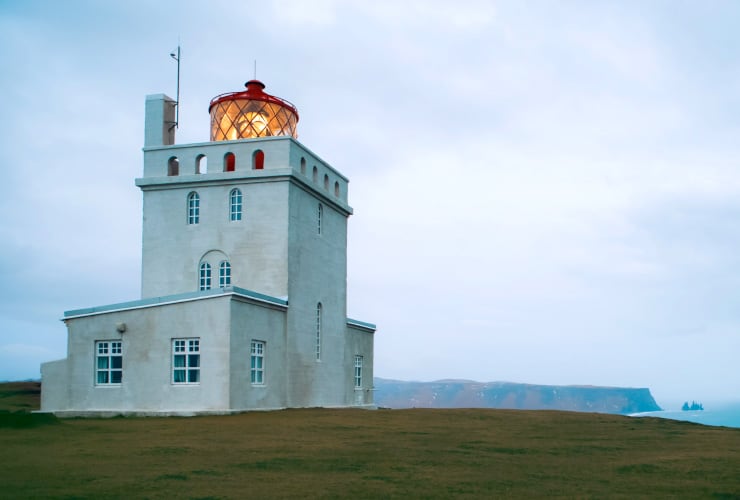
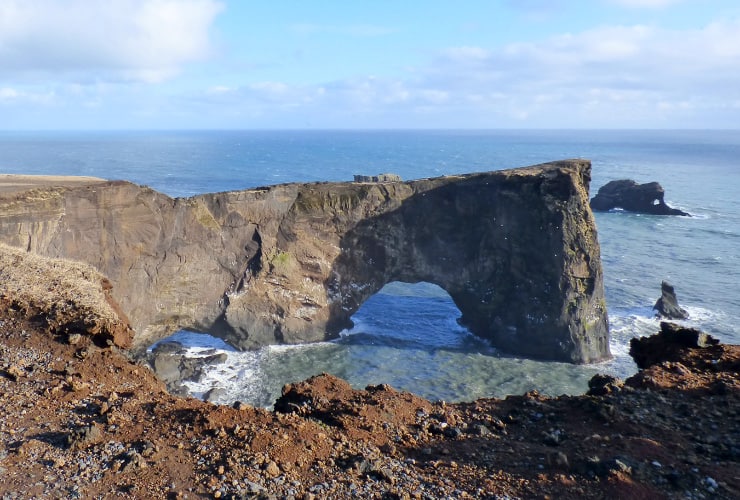
Goðafoss has three distinct areas of overflow, a narrow flow in the center surrounded by two wider falls converging in the river below. In total Goðafoss measures 39.4’ (12 m) high and 98.4’ (30 m) in width while taking on a bowl shape. There’s even a quaint little falls emerging out of a gap in the east rock face. Because it is fed by the Vatnajokull glacier, the water flow remains pretty constant all year round. As a bonus . . . if you follow the bright blue river downstream there is a magnificent falls, Geitafoss, just before you cross over the bridge.
Hvalnes Lighthouse
Pronounced: howl • ness
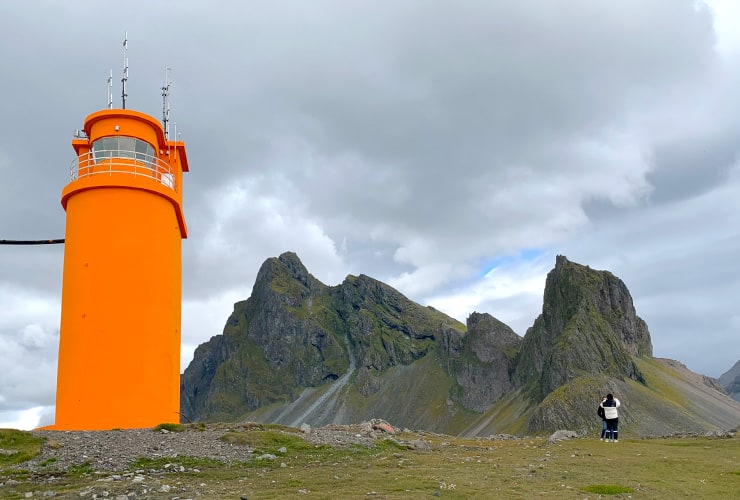
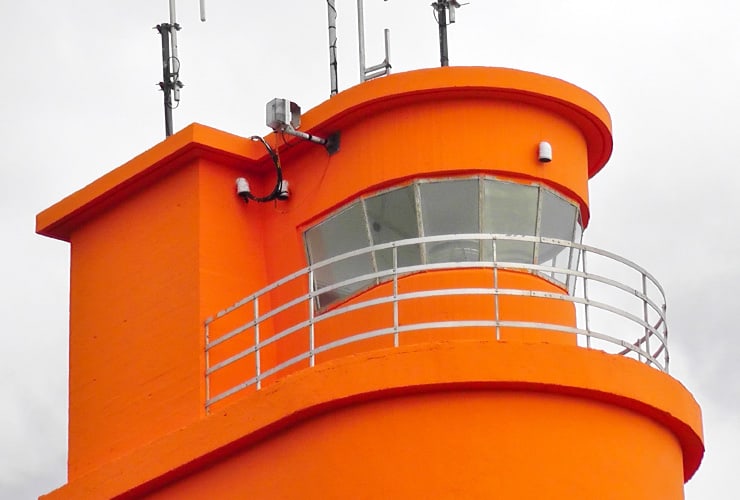
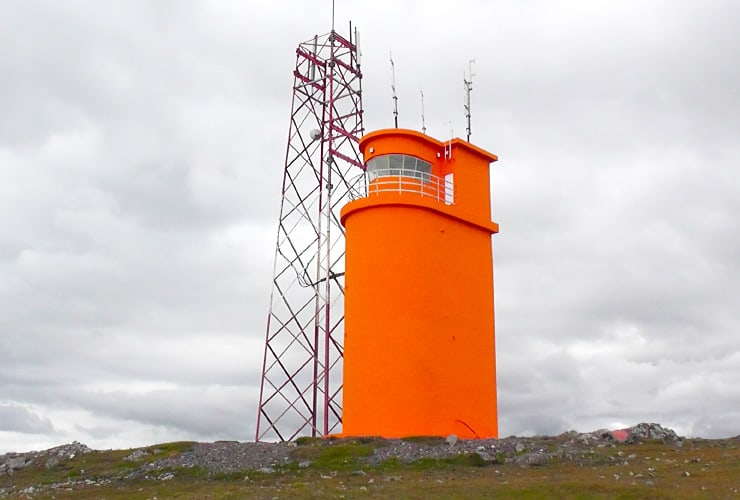
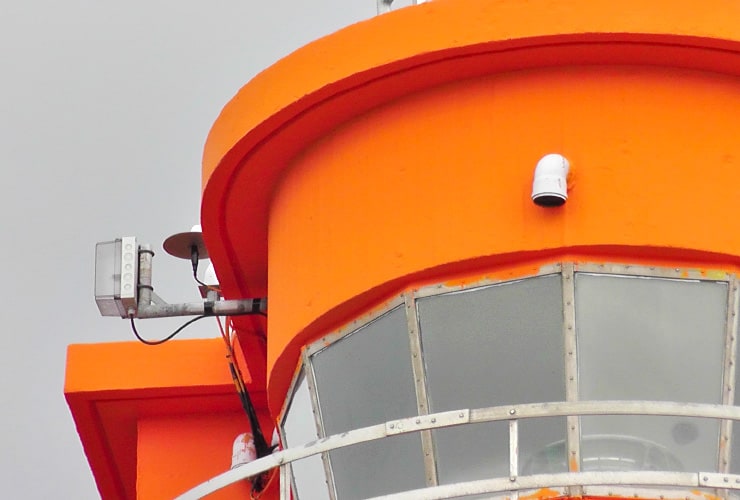
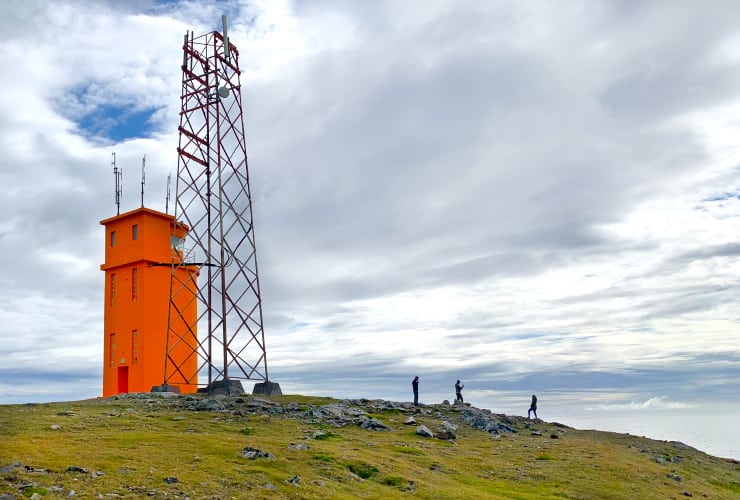
The Hvalnes Lighthouse is a personal favorite and one of the best Iceland beaches and lighthouses. The simple rectangular straight-line design, combined with its bright orange exterior creates a distinctive contrast to its barren surroundings. Located just off the Ring Road, about 32 miles (51 km) northeast of Höfn, the Hvalnes Lighthouse stands about 38’ (11.5 m) with a 95’ (29 m) focal plane. Hvalnes overlooks the Hvalnes Nature Reserve with its spectacular shoreline and is framed by the memorable Mount East Horn to the west. Operational in 1955, the lighthouse was the result of a collaboration of house designer Einar Stefánsson and engineer Axel Sveinsson.
Hrólfsskersviti Lighthouse
Pronounced: shoals • care • reevey
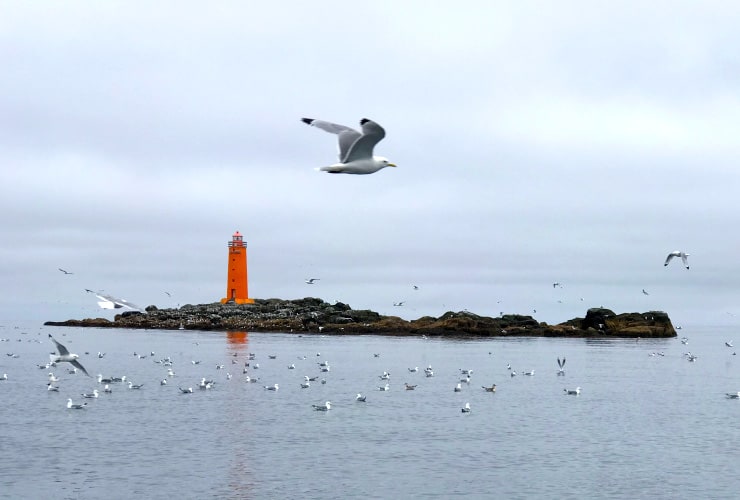
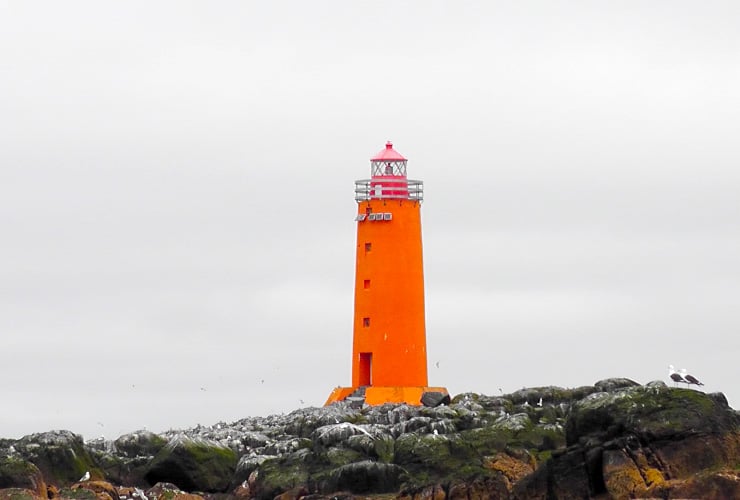
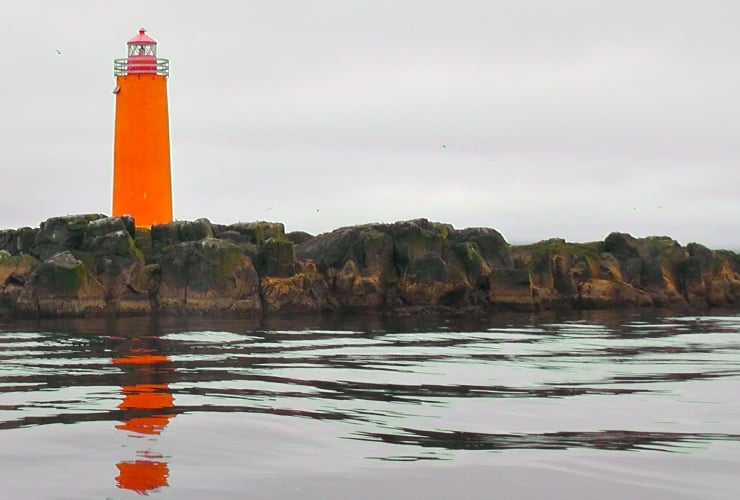
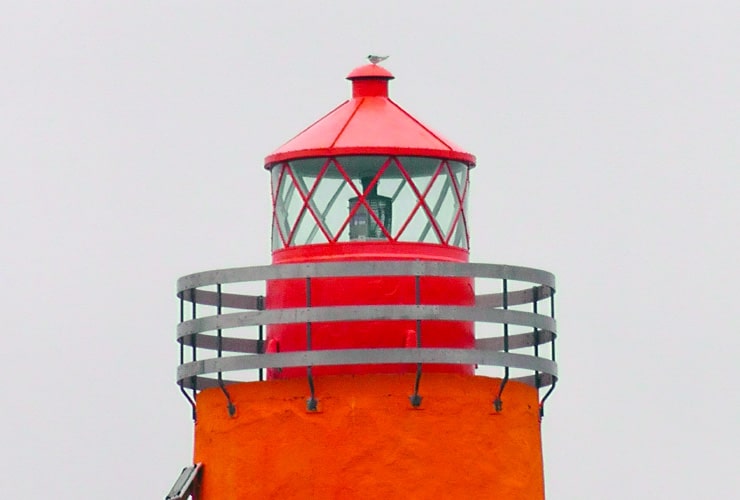
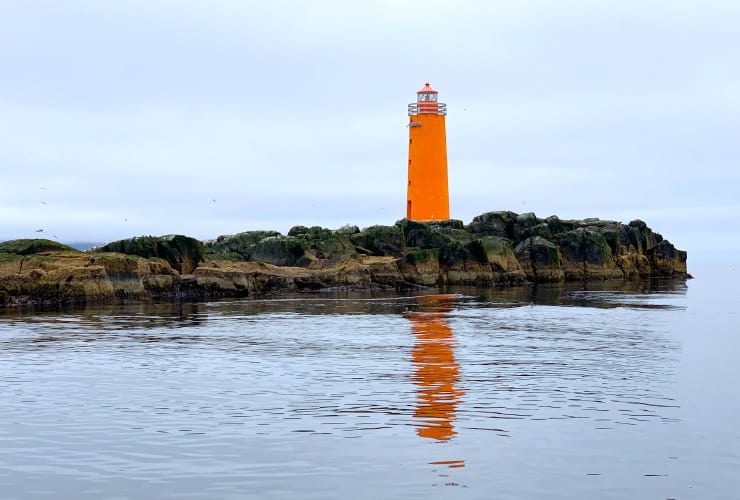
One of the highlights of our whale watching adventure was the Hrólfsskersviti Lighthouse. In the middle of the narrow Eyjafjörður fjord is a narrow rock island whose only inhabitant is the Hrólfsskersviti Lighthouse. Like so many of Iceland’s lighthouses, Hrólfsskersviti was built in the mid-20th century. Standing 52’ (16 m) in height with a focal plane of only 59’ (18 m) the bright orange structure is surrounded by grey seals and swarms of Northern Fulmar birds who have decorated both the lighthouse and the surrounding rocks. From Hrólfsskersviti you can see remarkable Mígandifoss.
Trollaskagi Lighthouse
Pronounced: flub • loss • guy
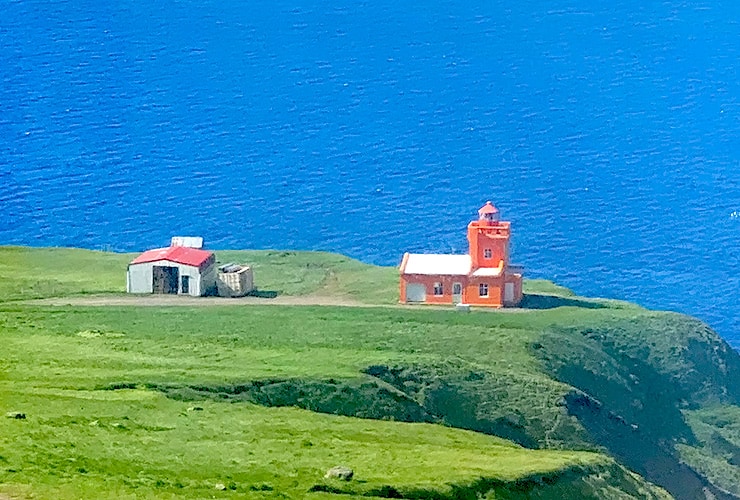
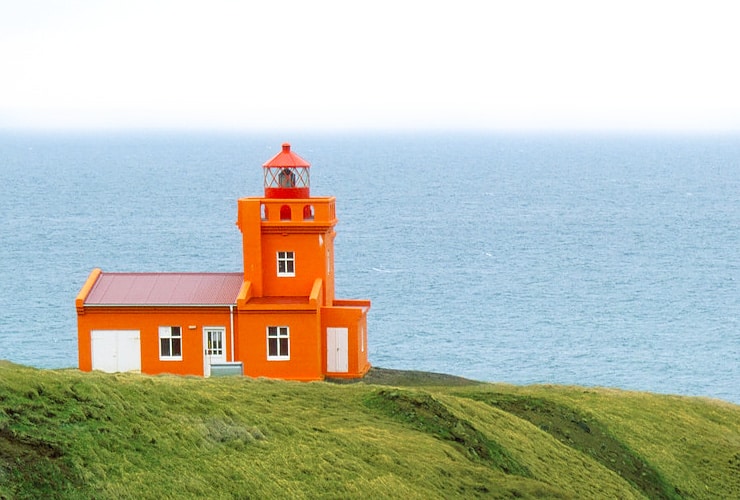
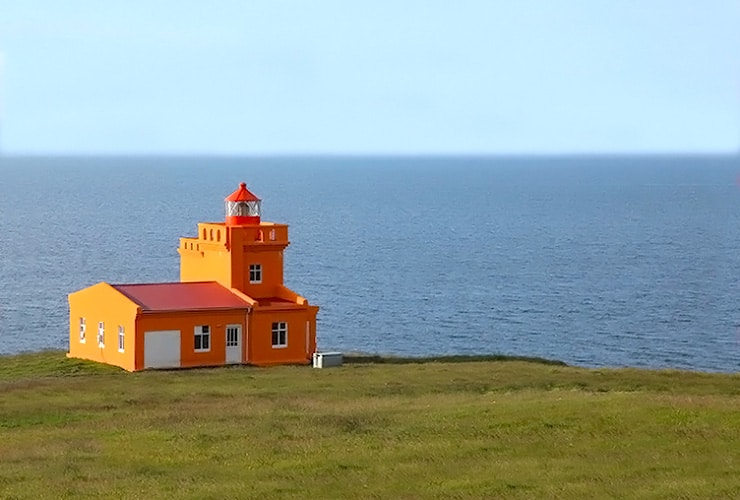
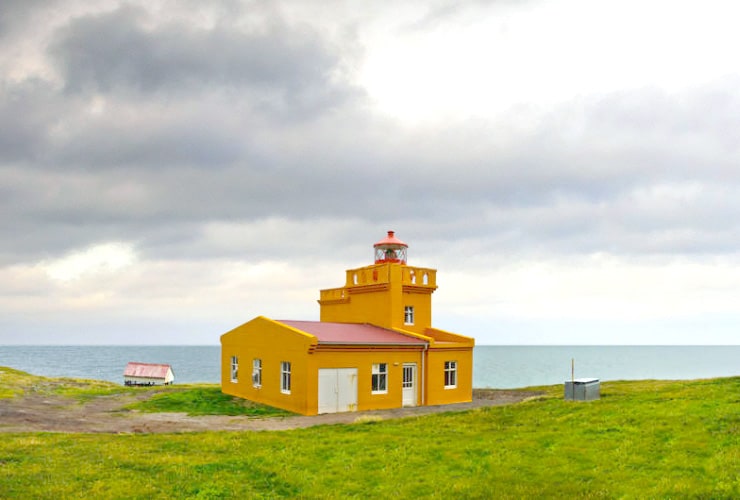
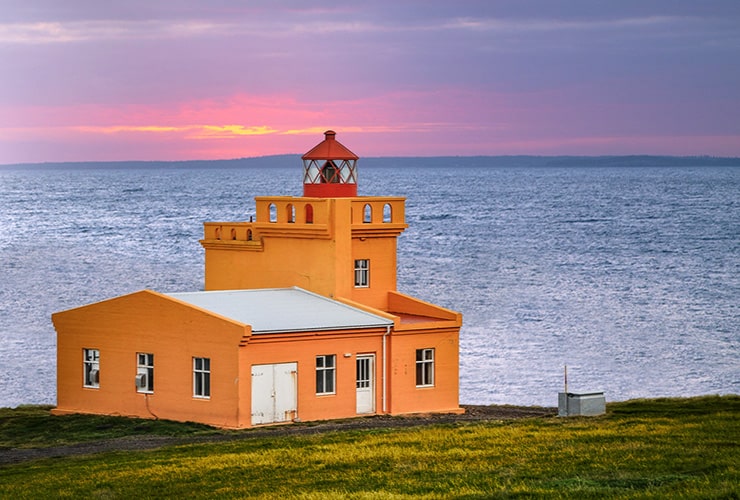
As you approach the northern most point on the Ring Road, in the Siglufjörður region, your eye notices an orange spec perched atop a mighty bluff overlooking the Atlantic Ocean. The orange and white roofed Trollaskagi Lighthouse resembles square boxes stacked one upon the other with a red tower on top. The tower reaches 34’ (10.5 m) with a focal plane of 121’ (37 m). Because of its isolation and sparse surroundings Trollaskagi, also known as Sauðanesviti, really stands out visually against the green grass of summer and the white snow in winter.
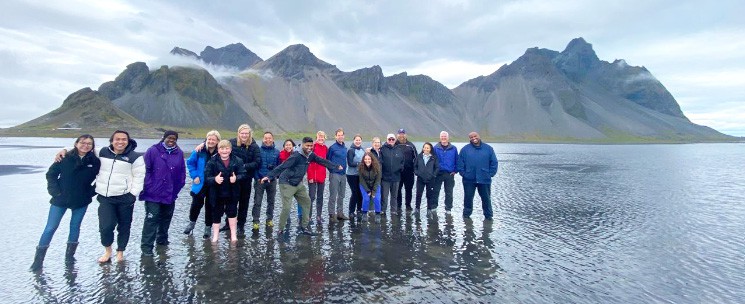
Along with waterfalls, lighthouses are a personal favorite. They share the luxury of being a part of the nature that surrounds them. For lighthouses there is also the nostalgia that hearkens back to a simpler, and often more treacherous, time. While we aren’t what you would call beachcombers, the beaches of Iceland are otherworldly and best enjoyed from the safe confines of the volcanic sand beaches.
We hope you’ve enjoyed our list of best Iceland beaches and lighthouses. We’d love to hear your feedback and observations. If you’ve been to Iceland, what beaches or lighthouses would you add to the list?

